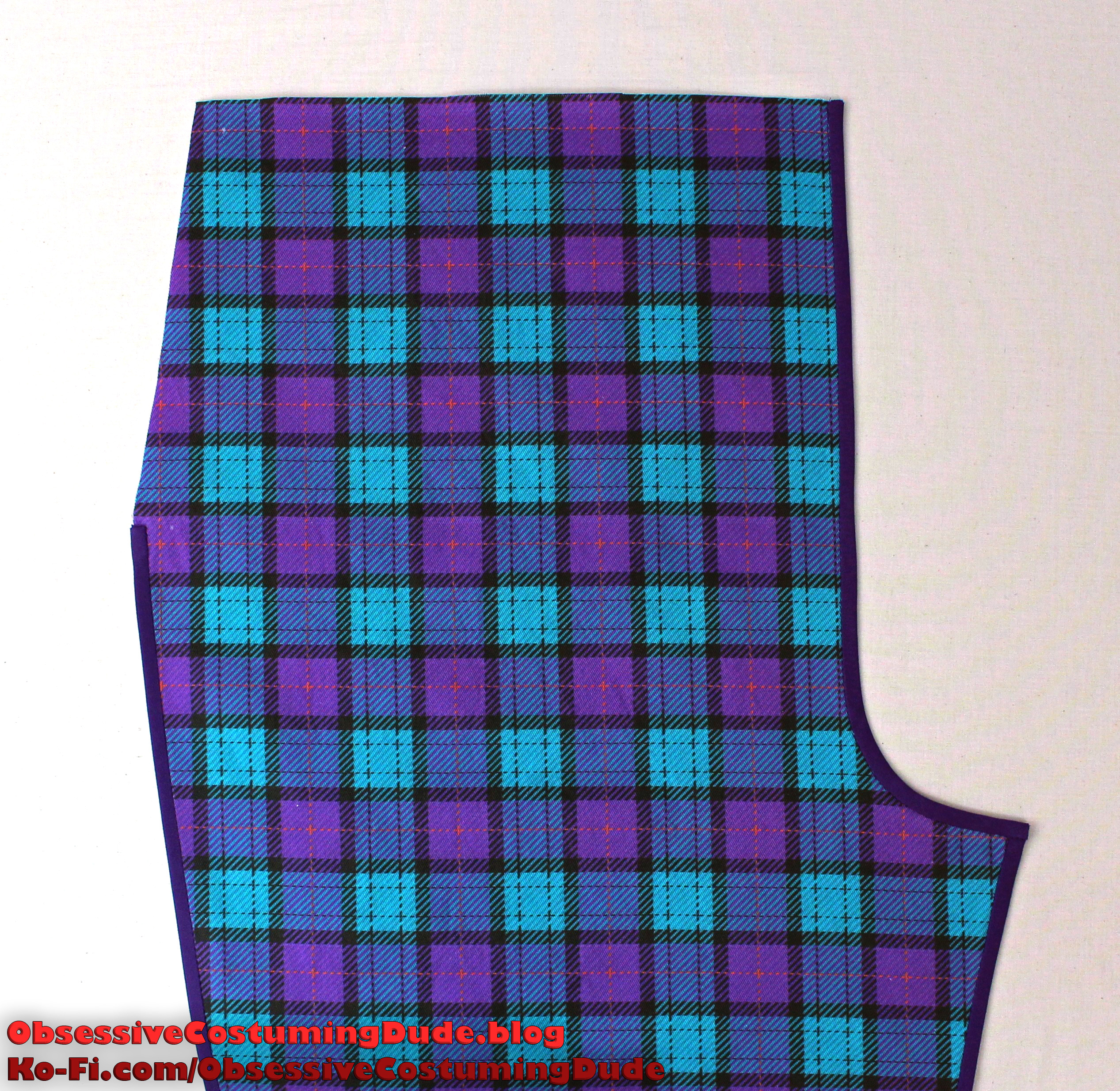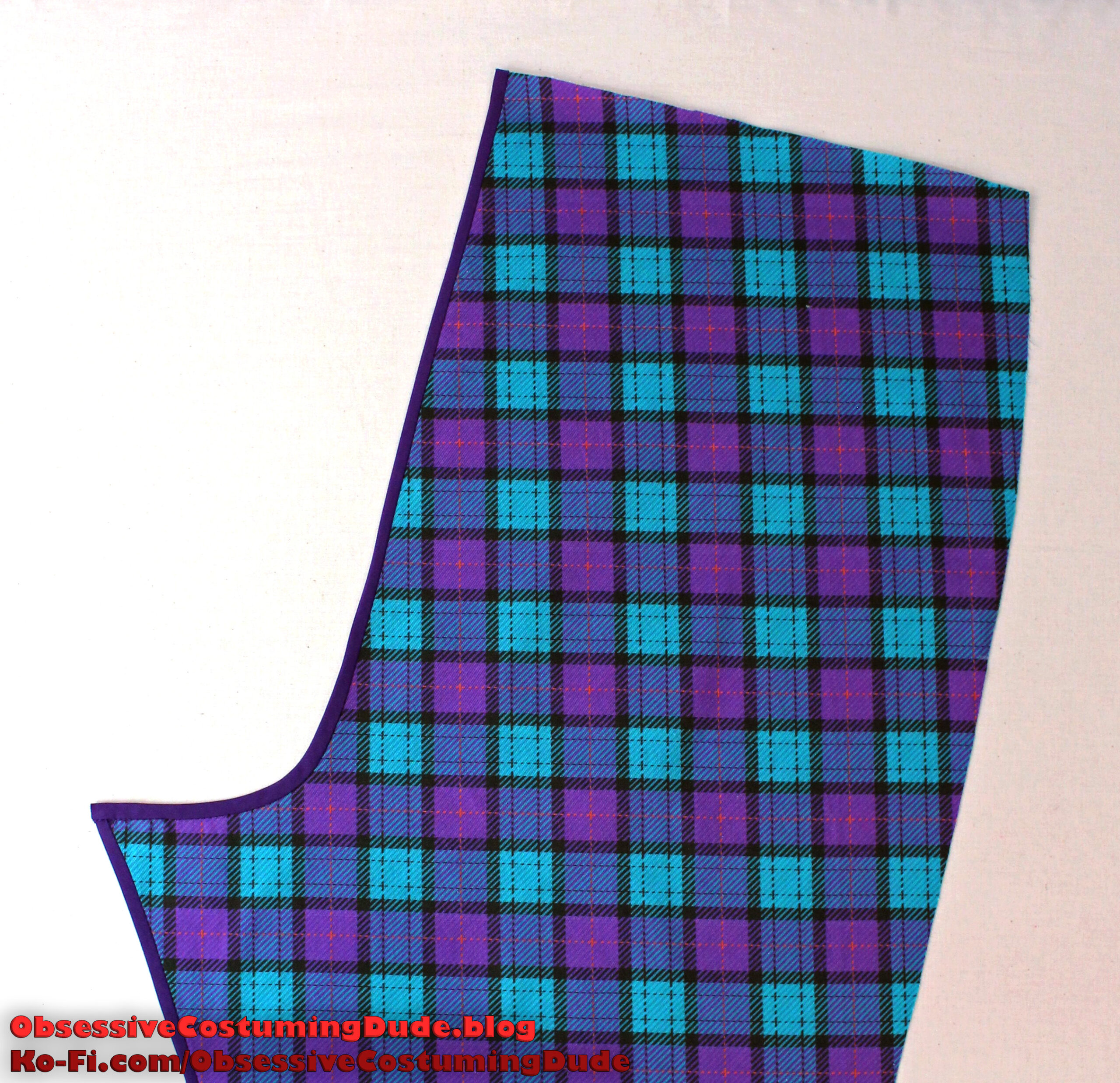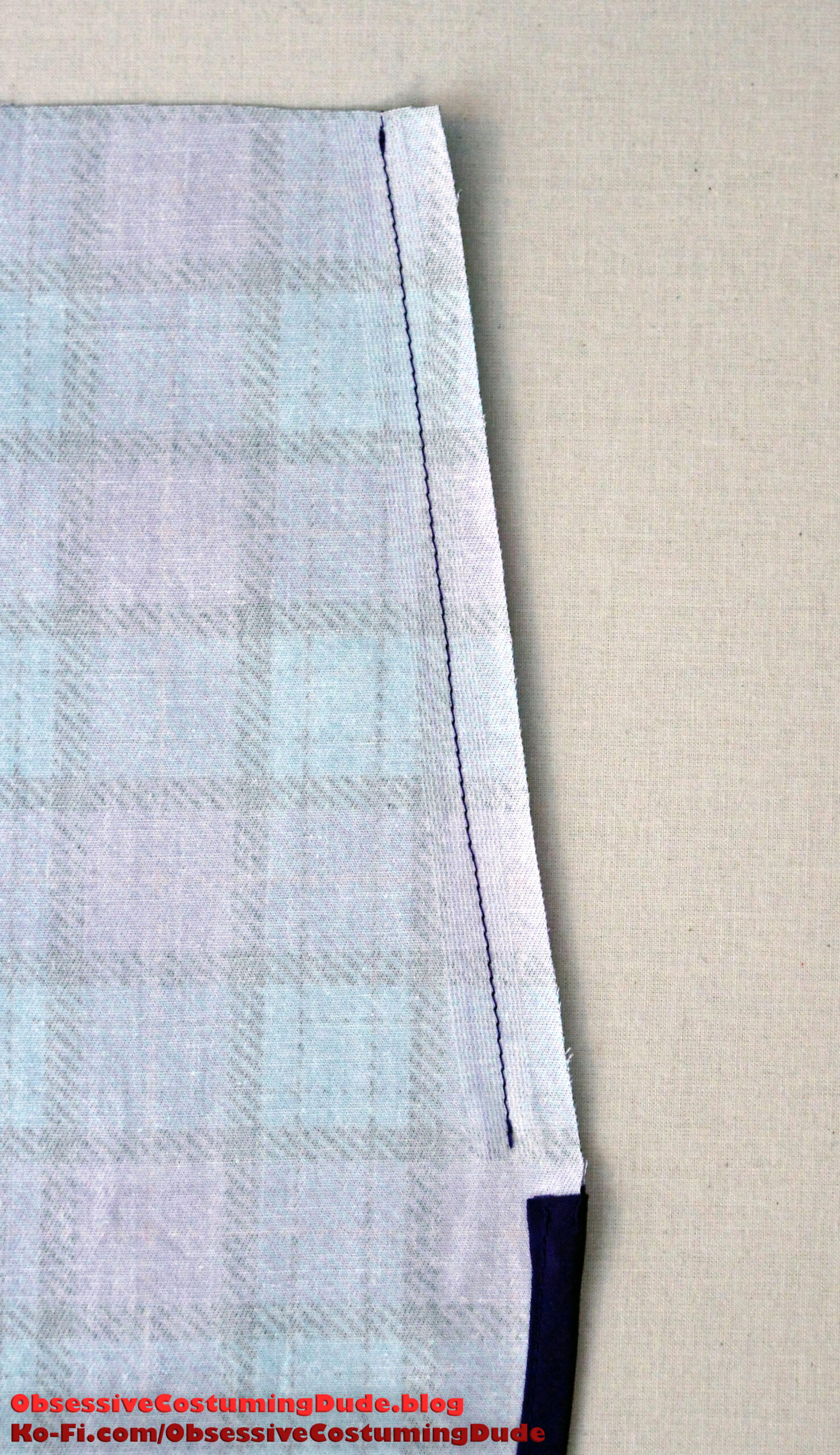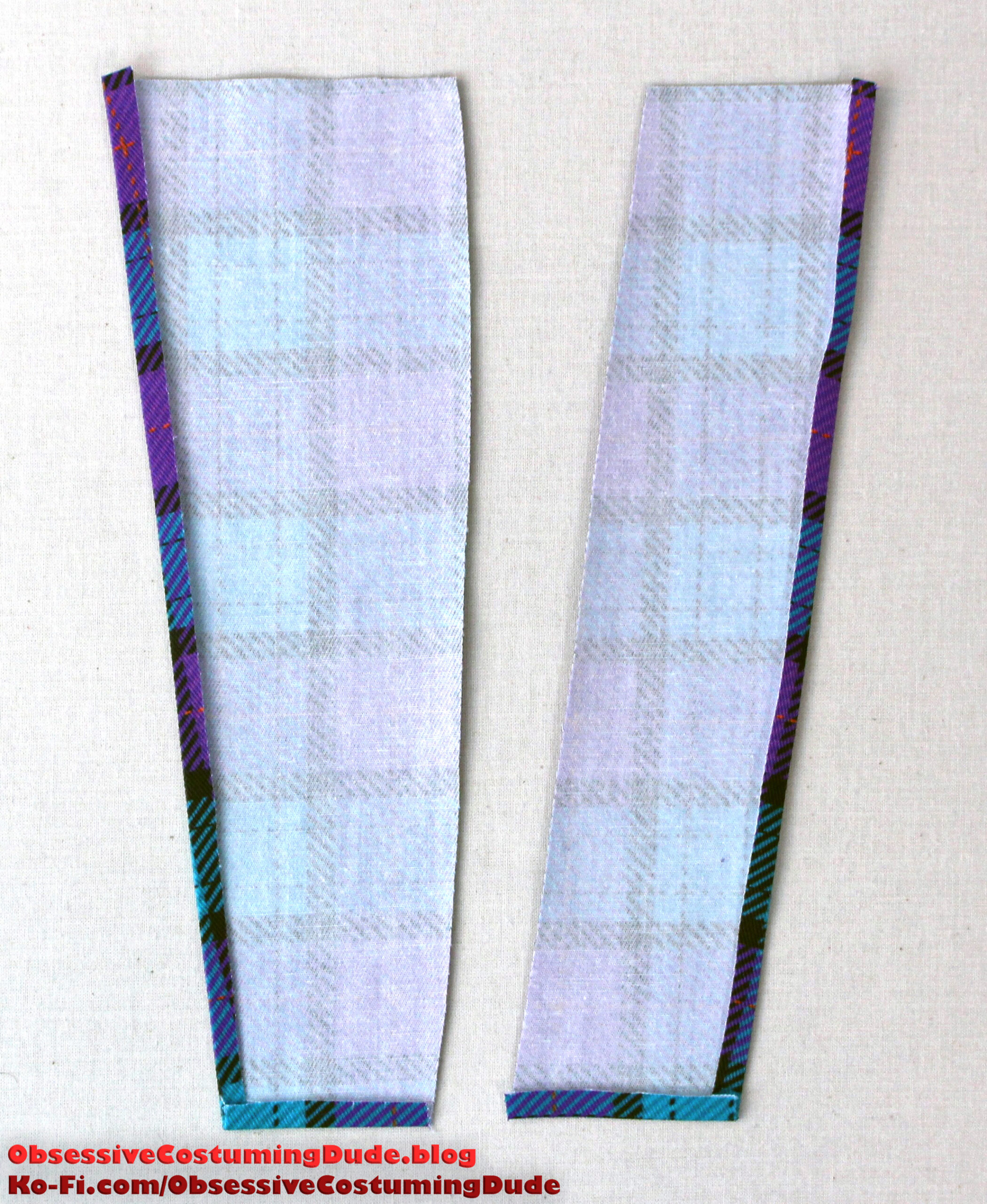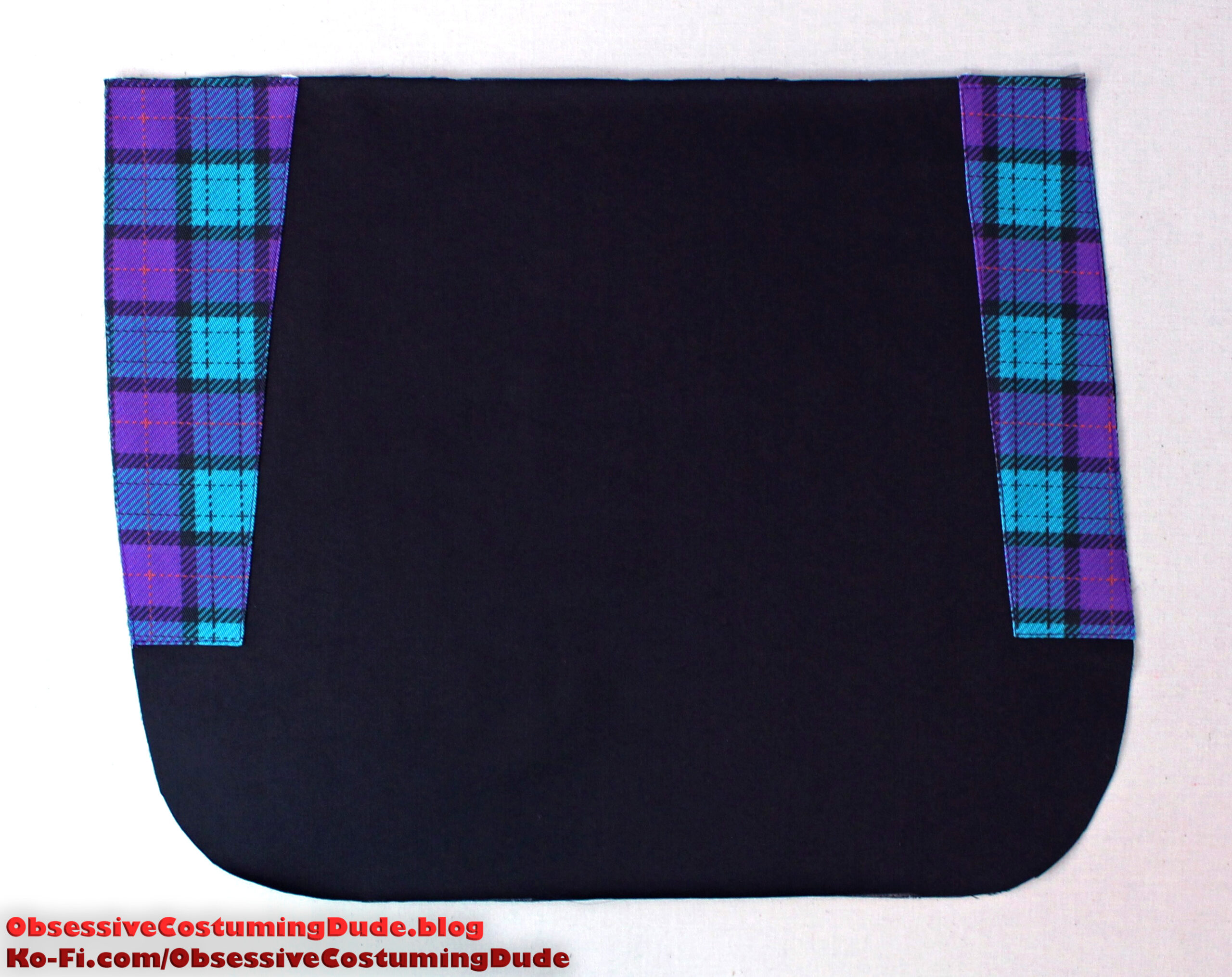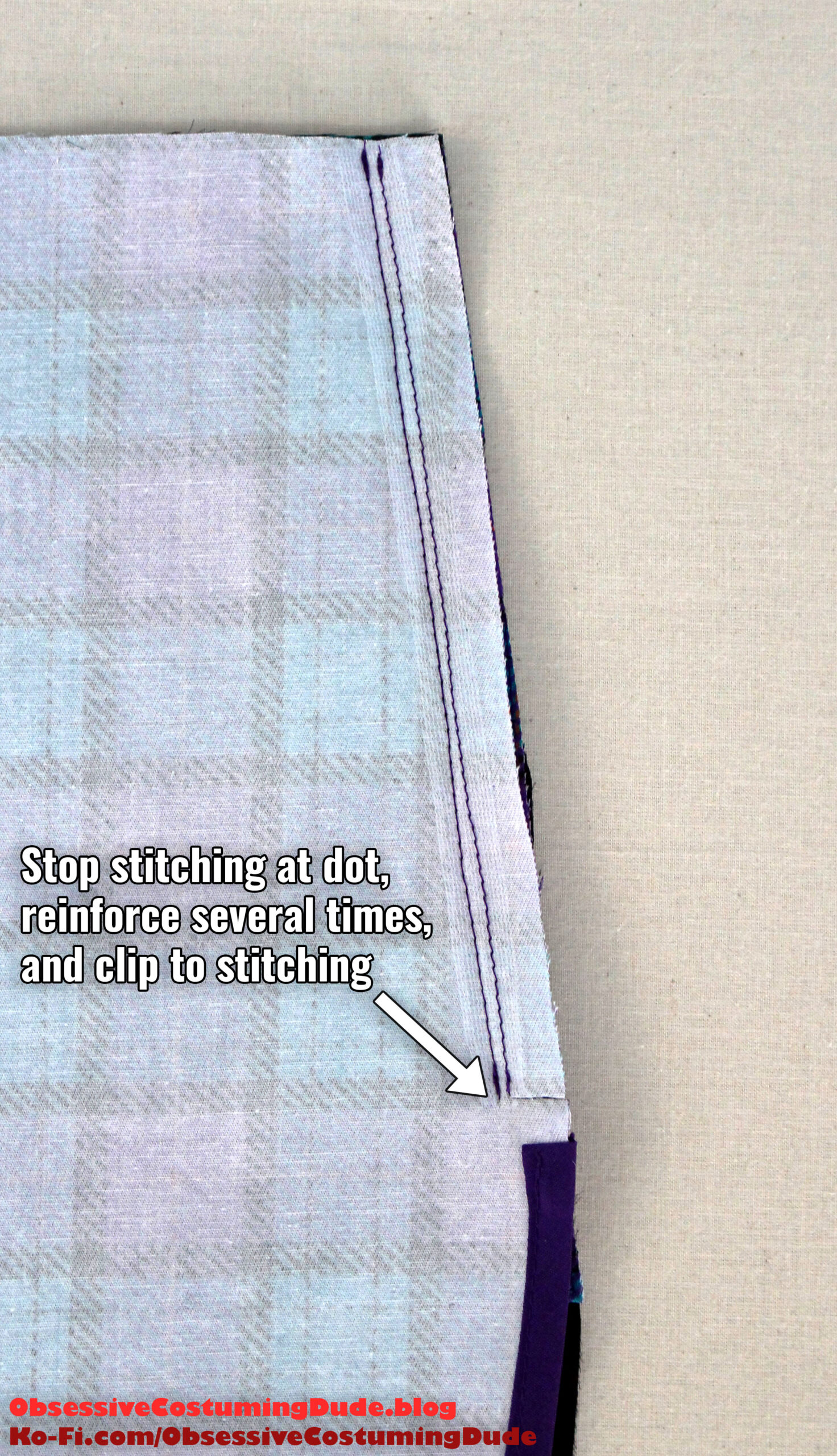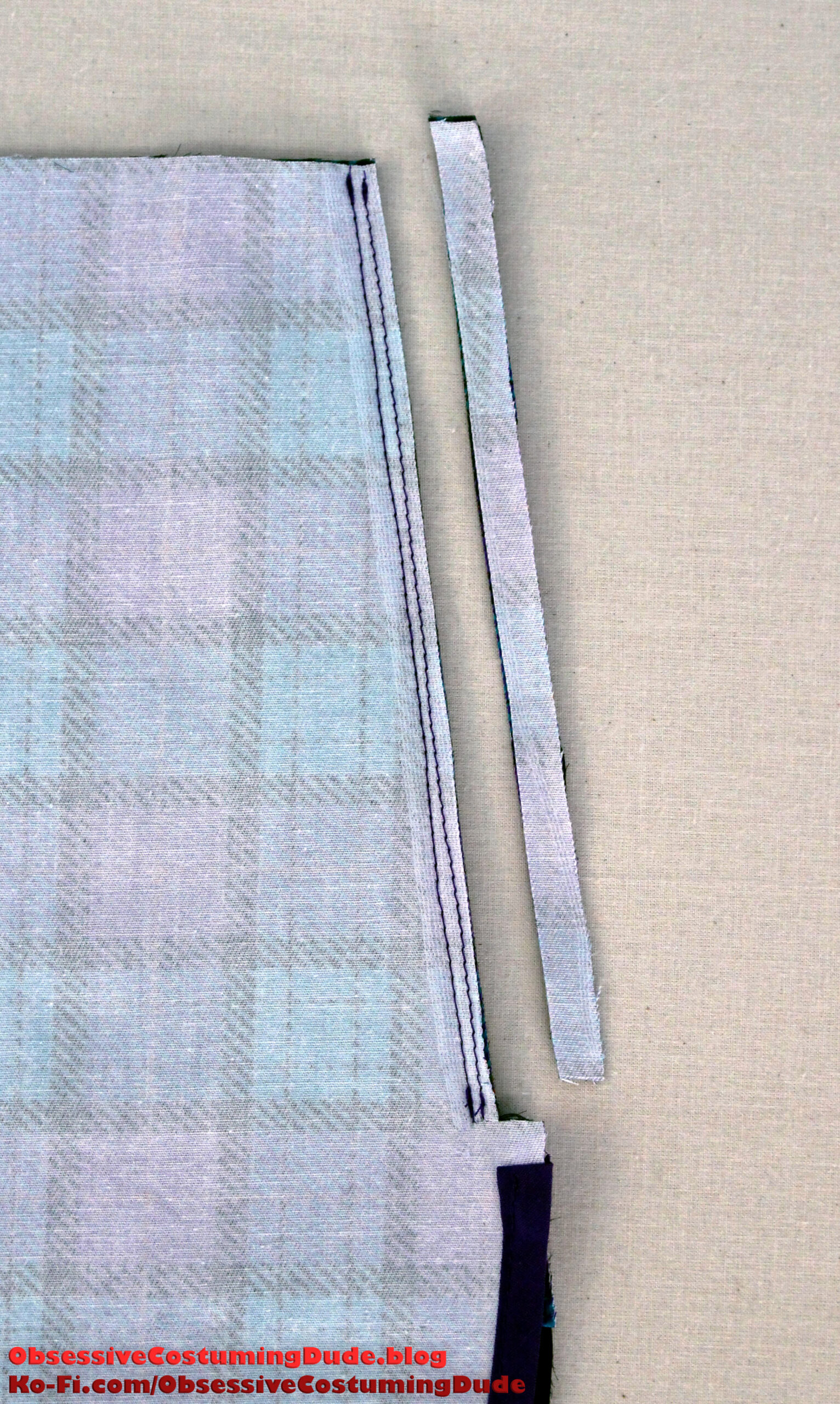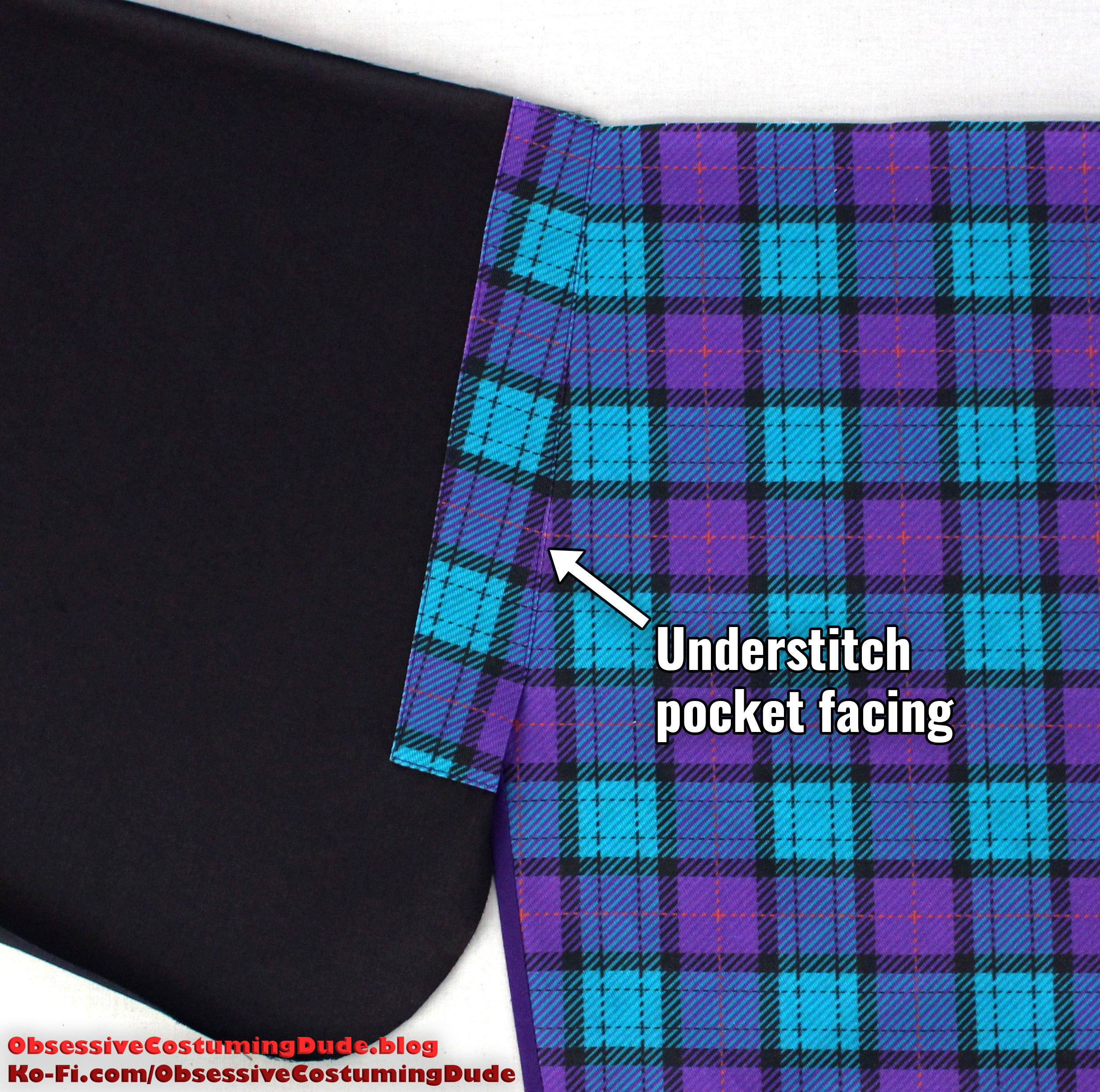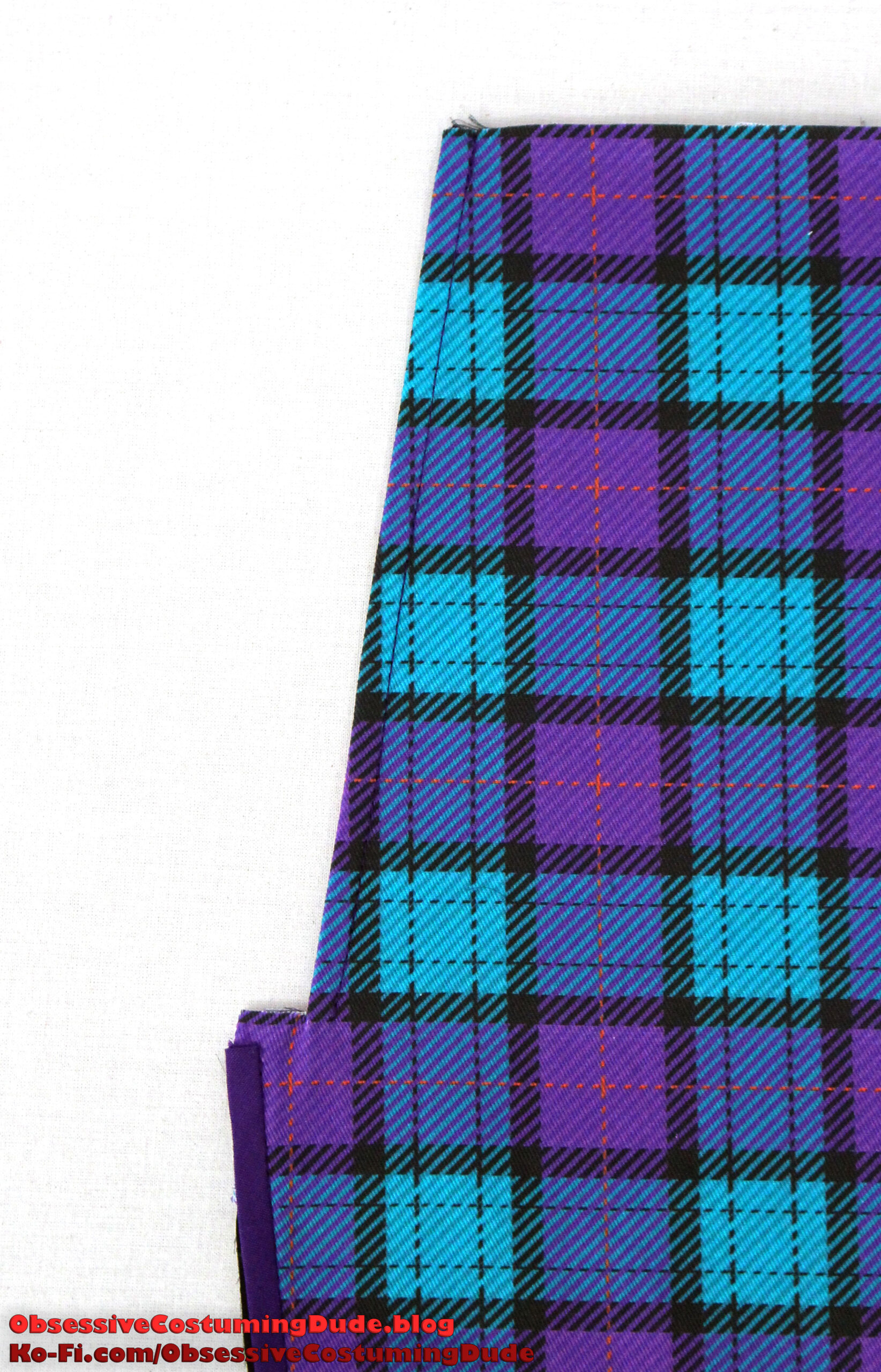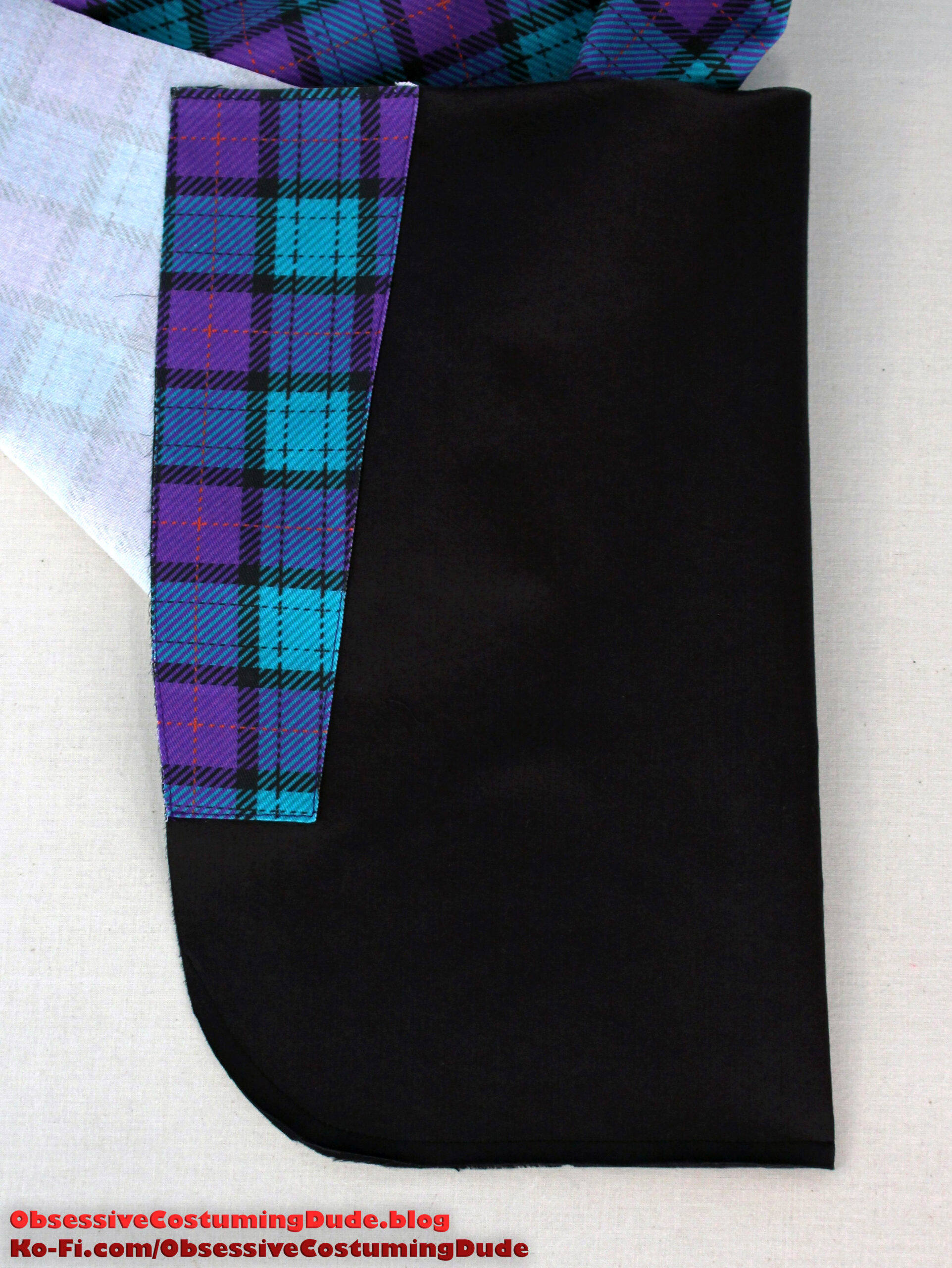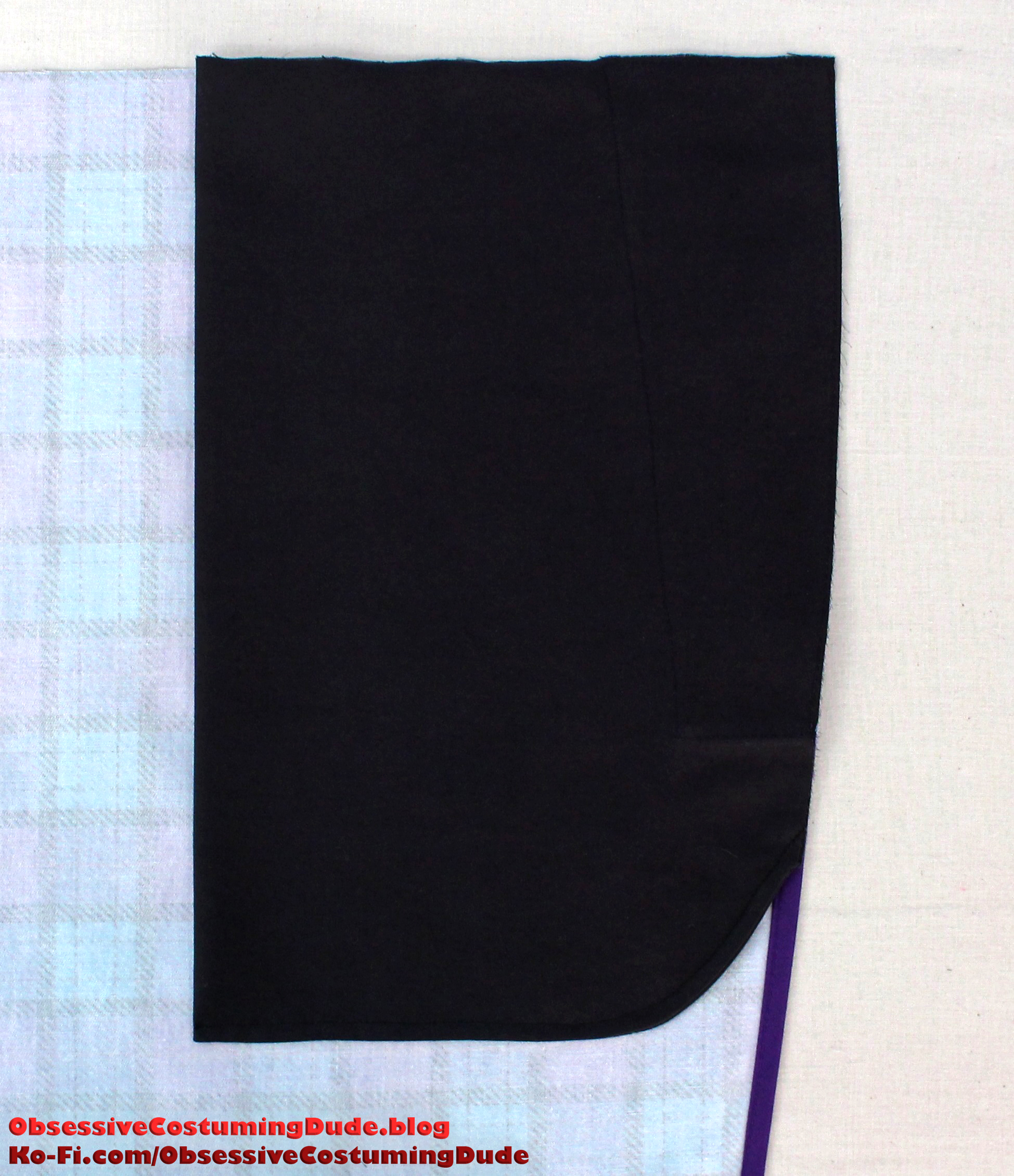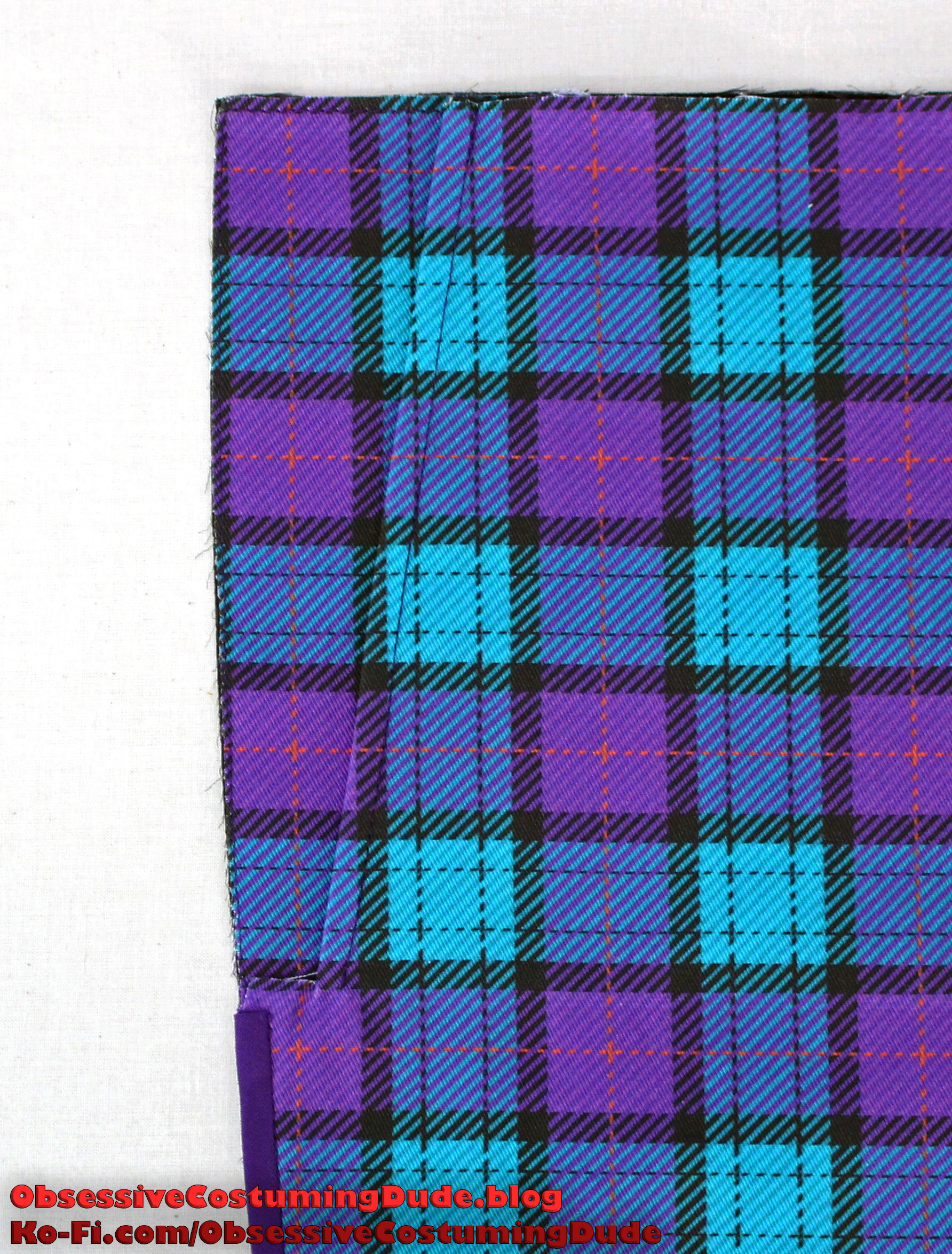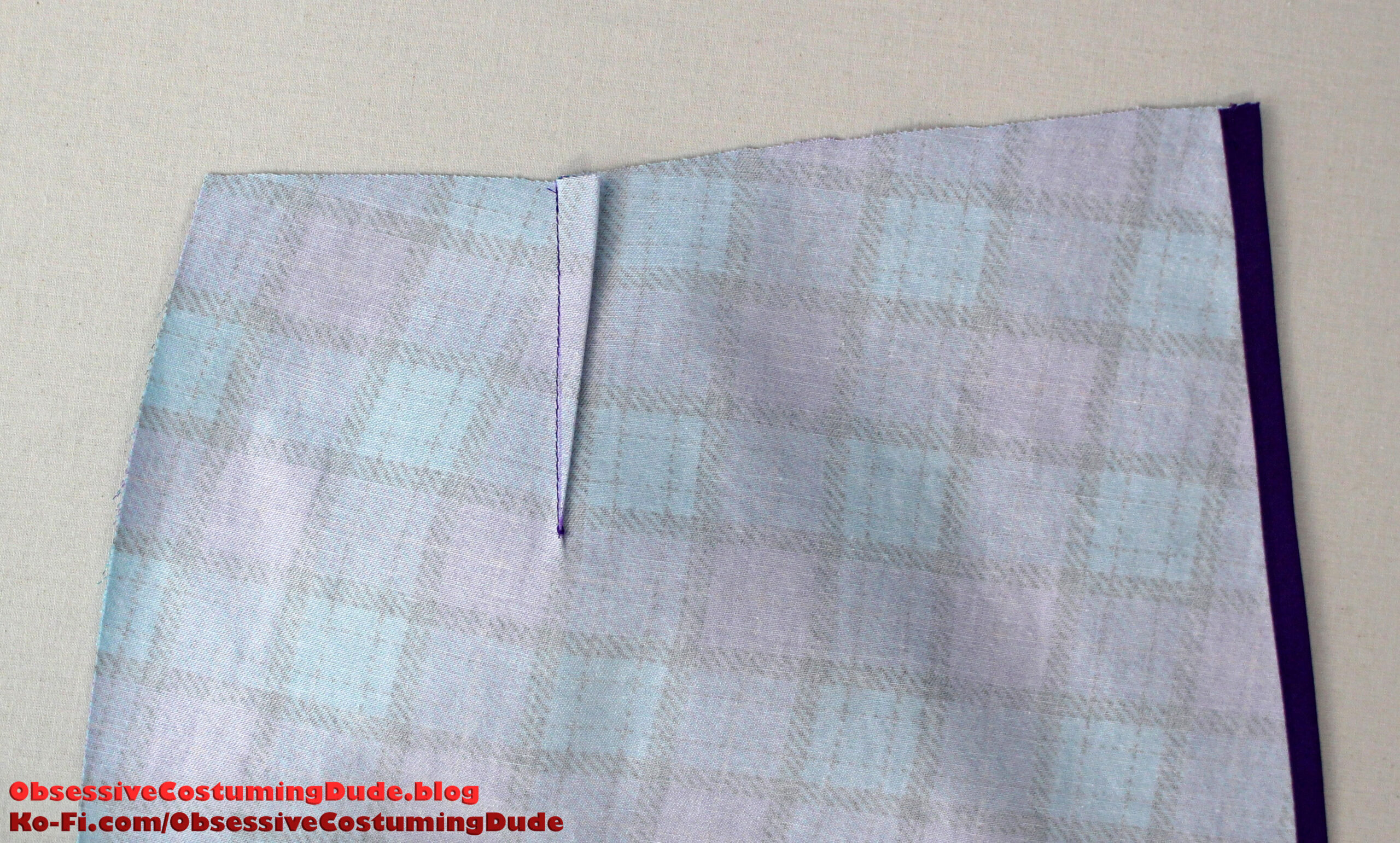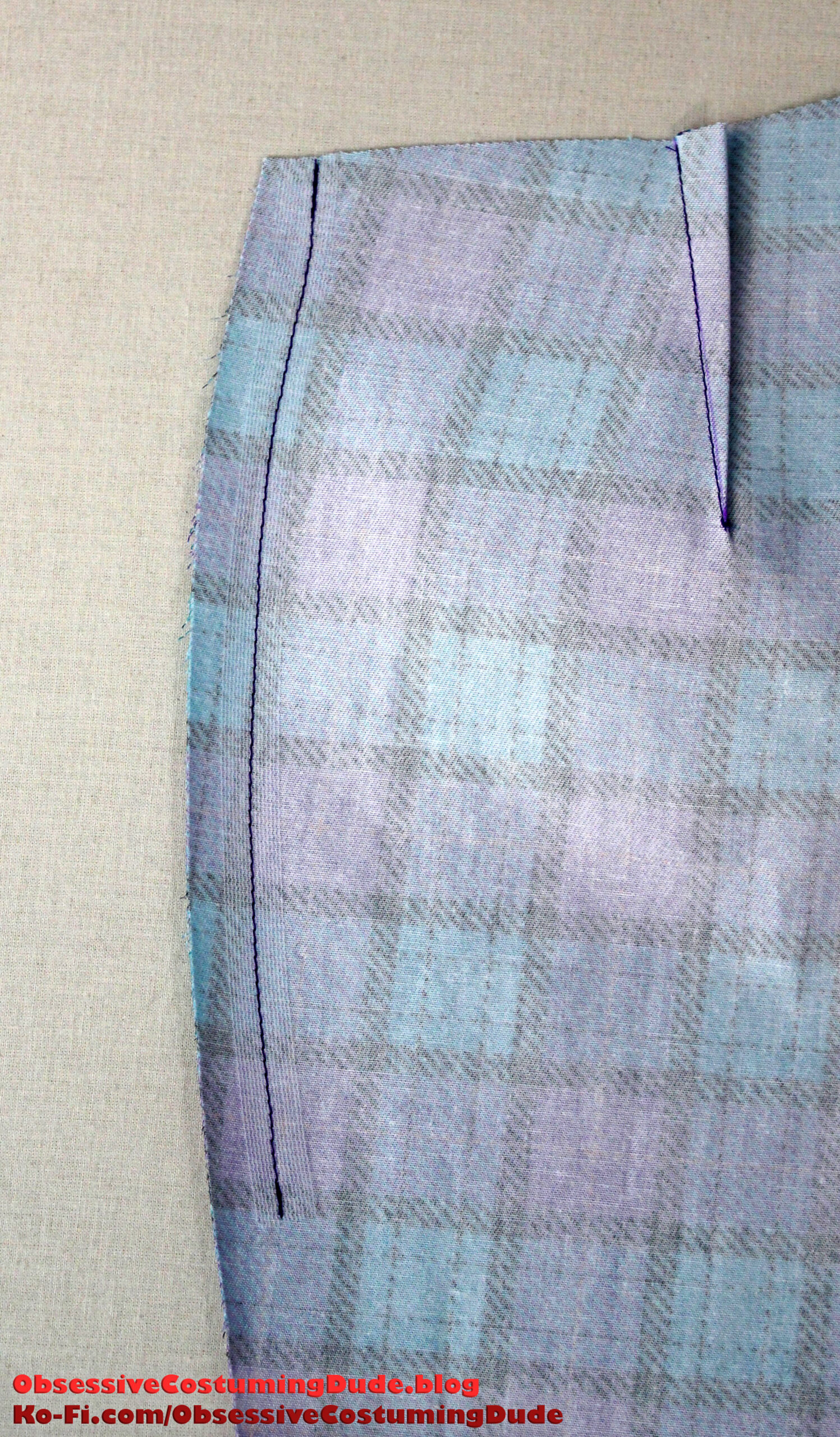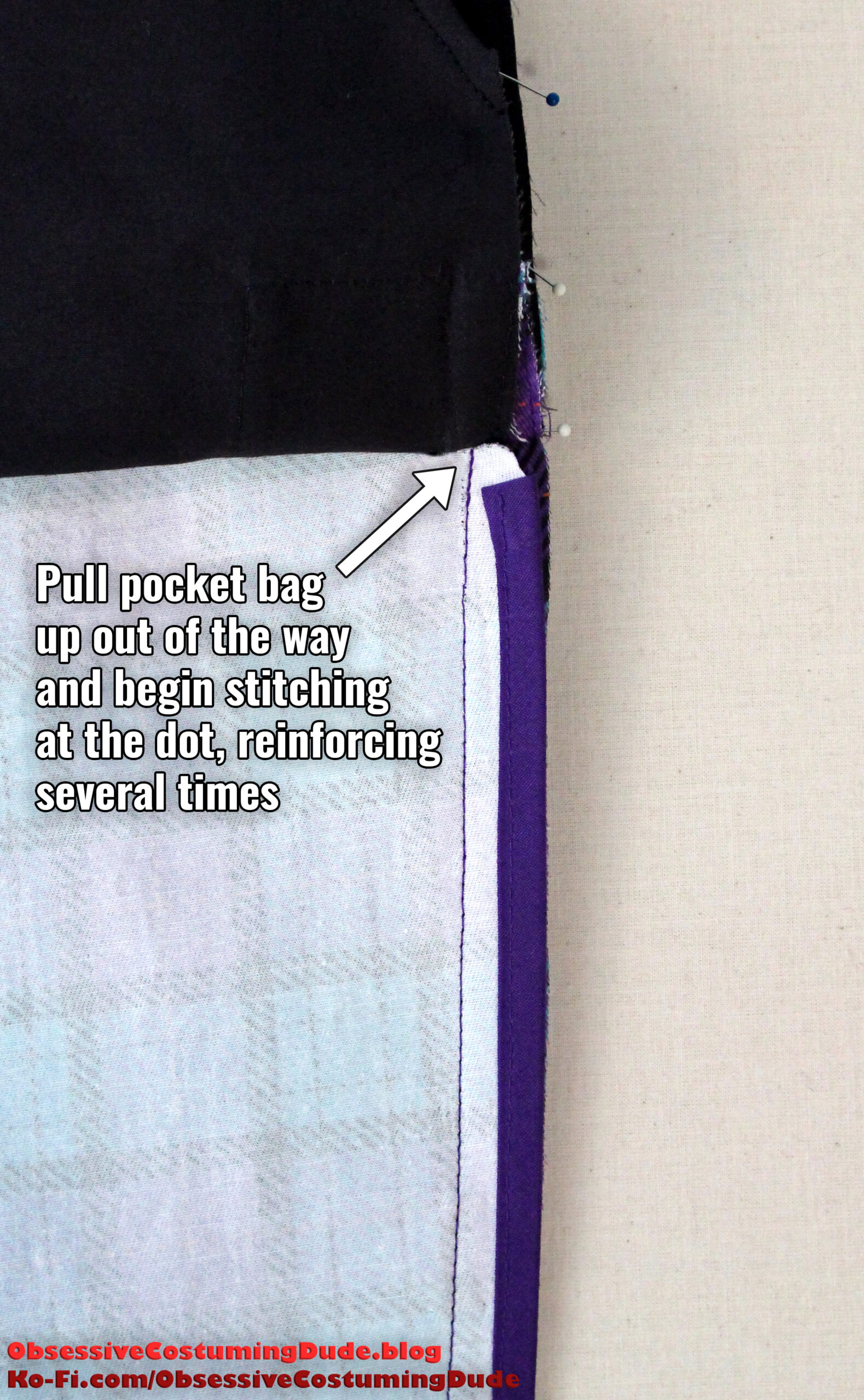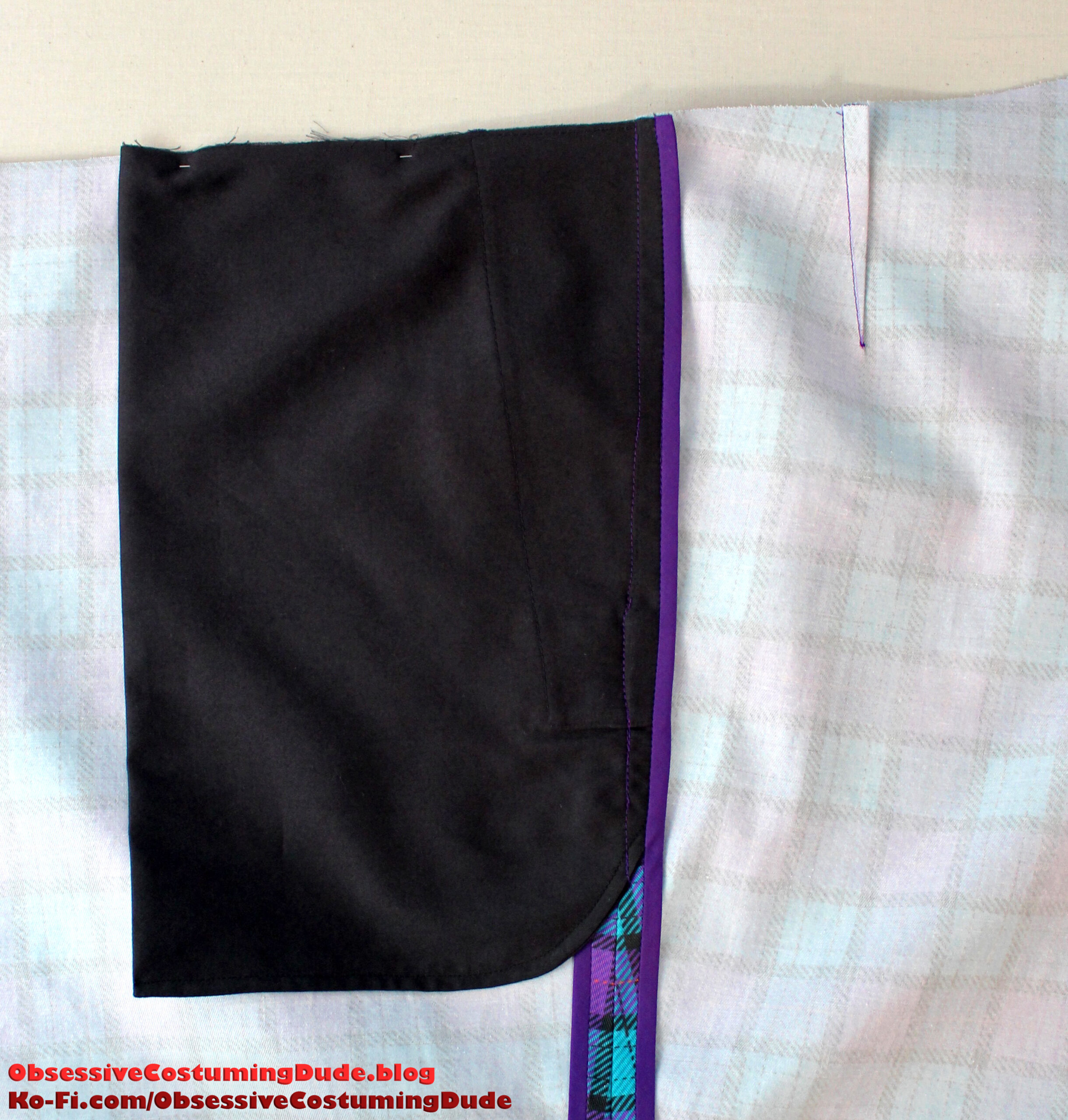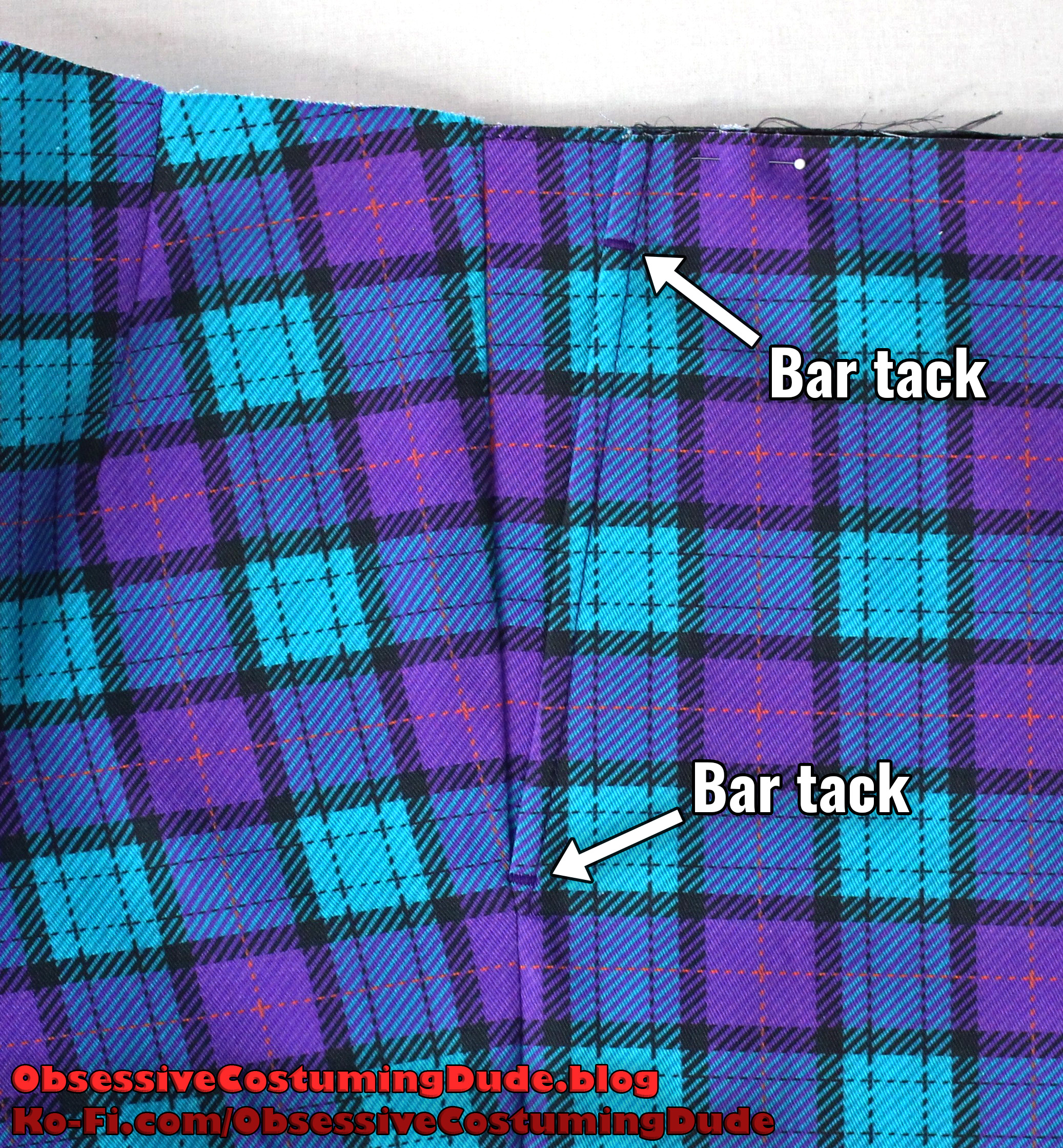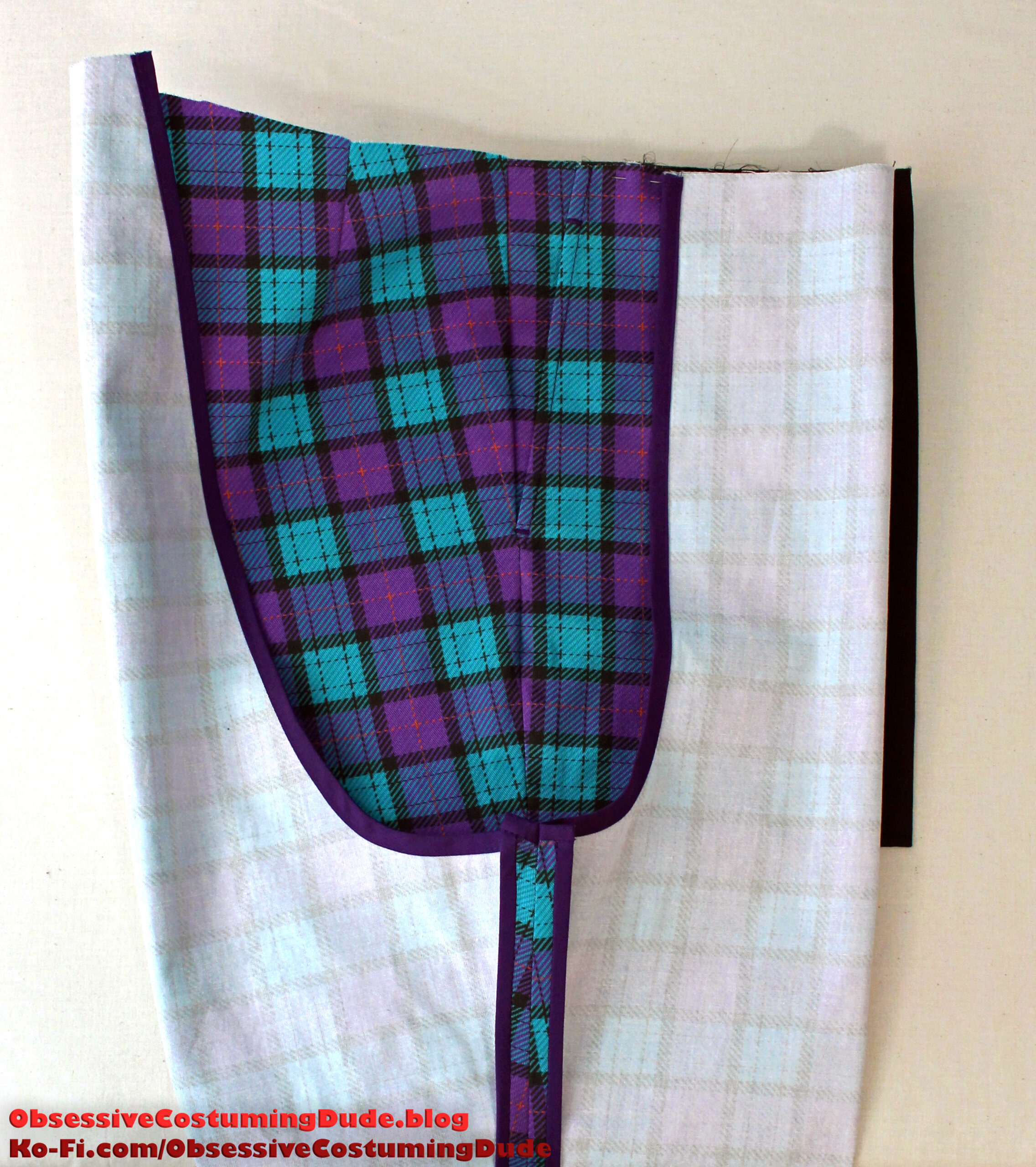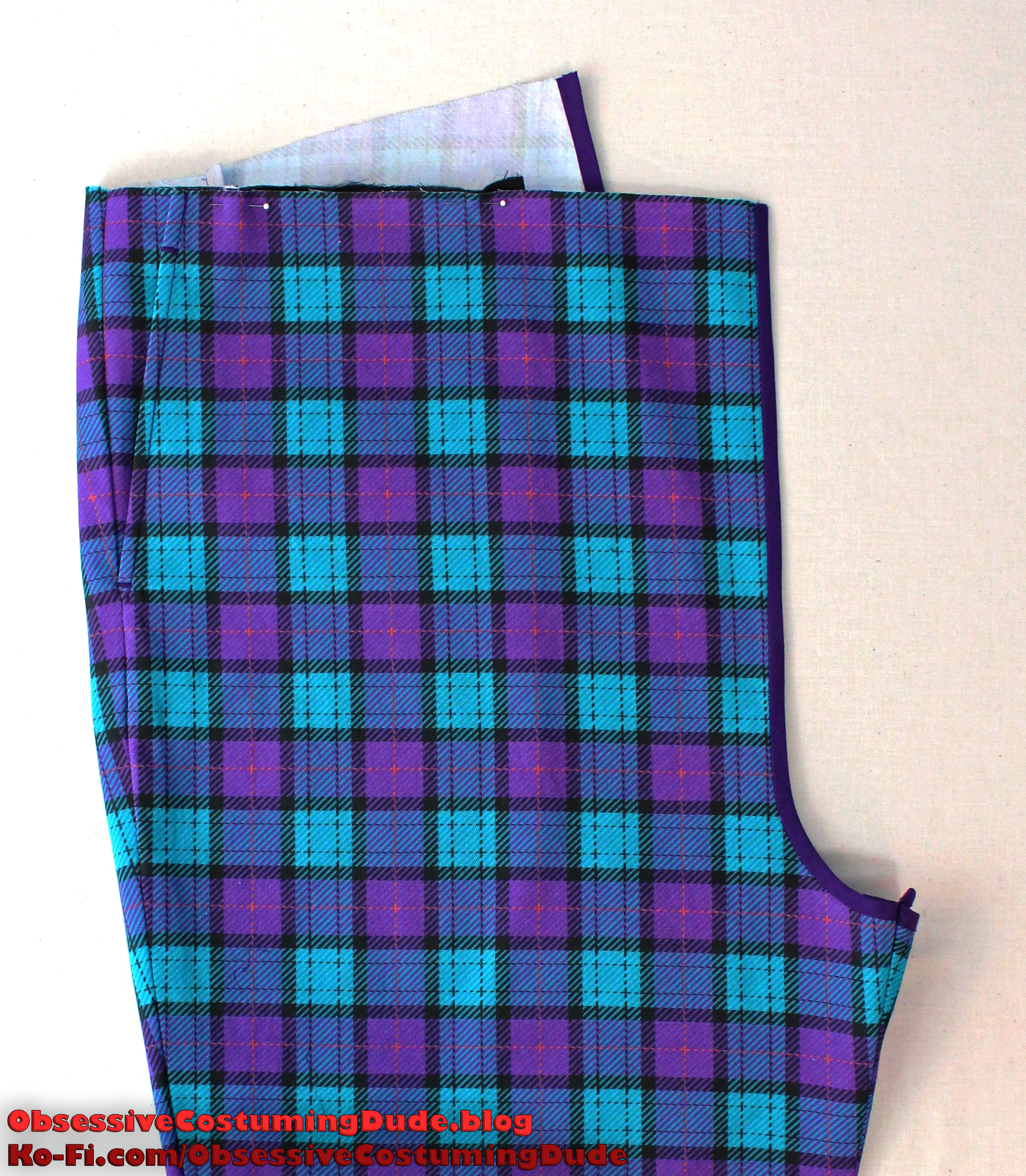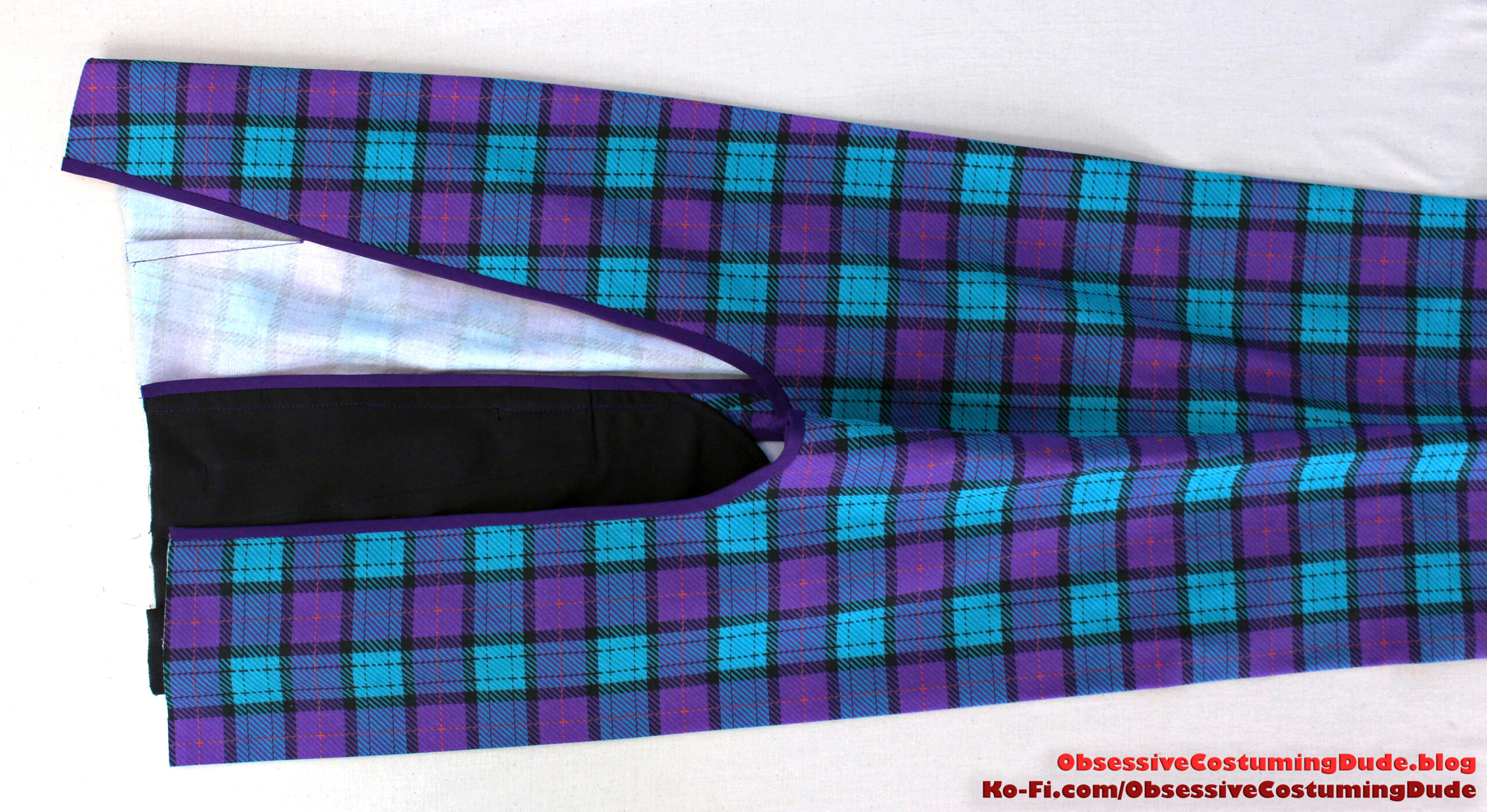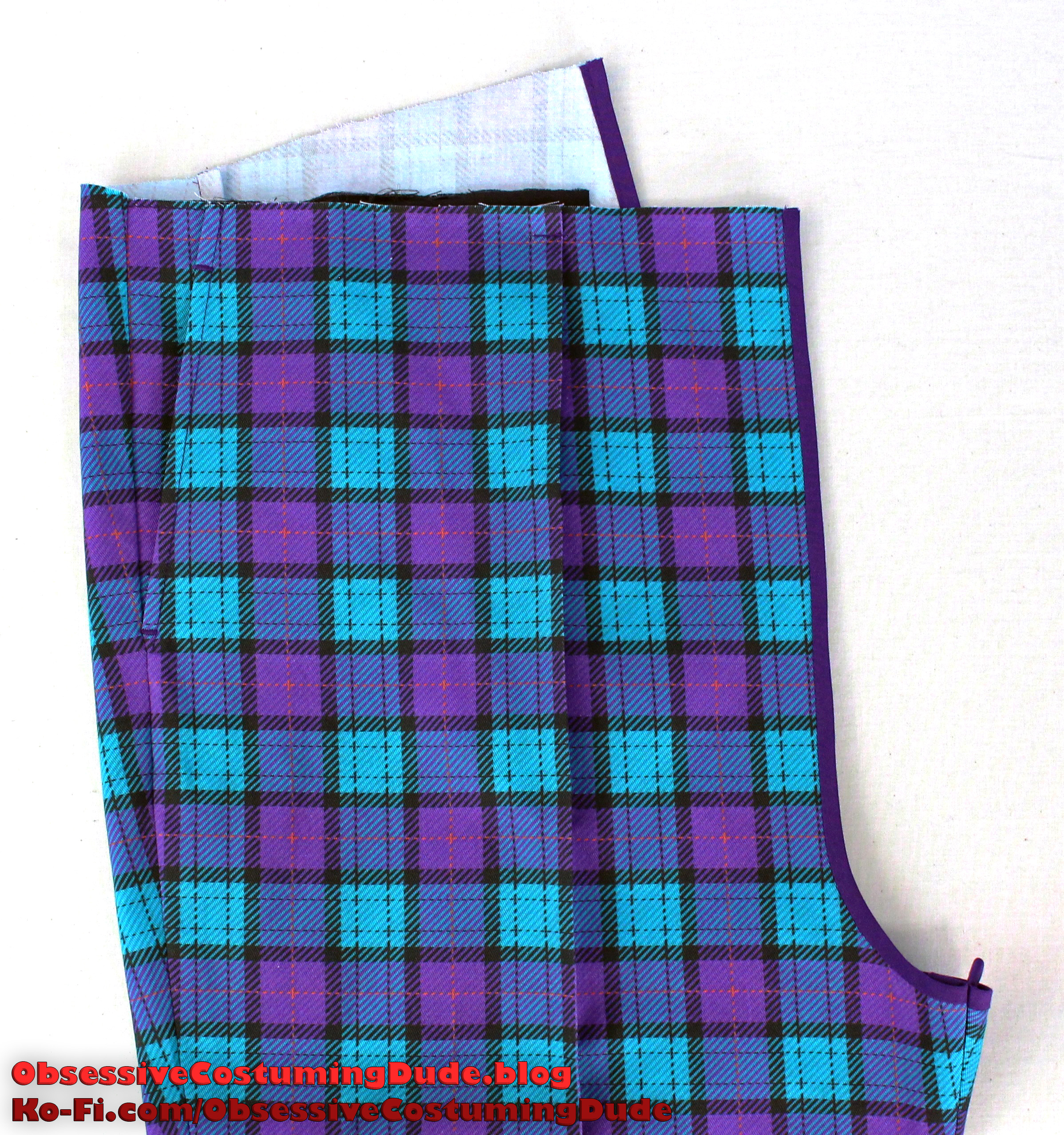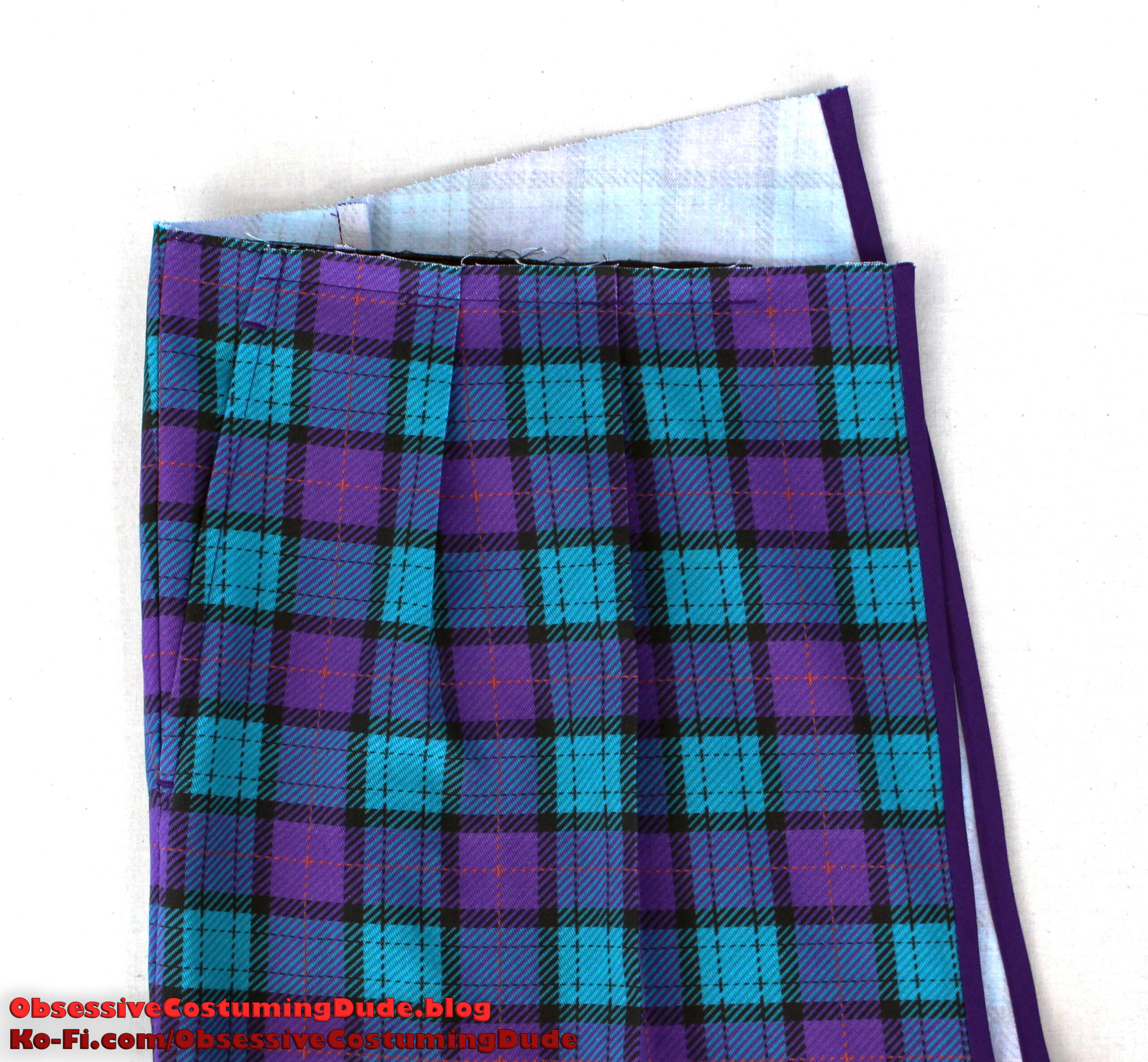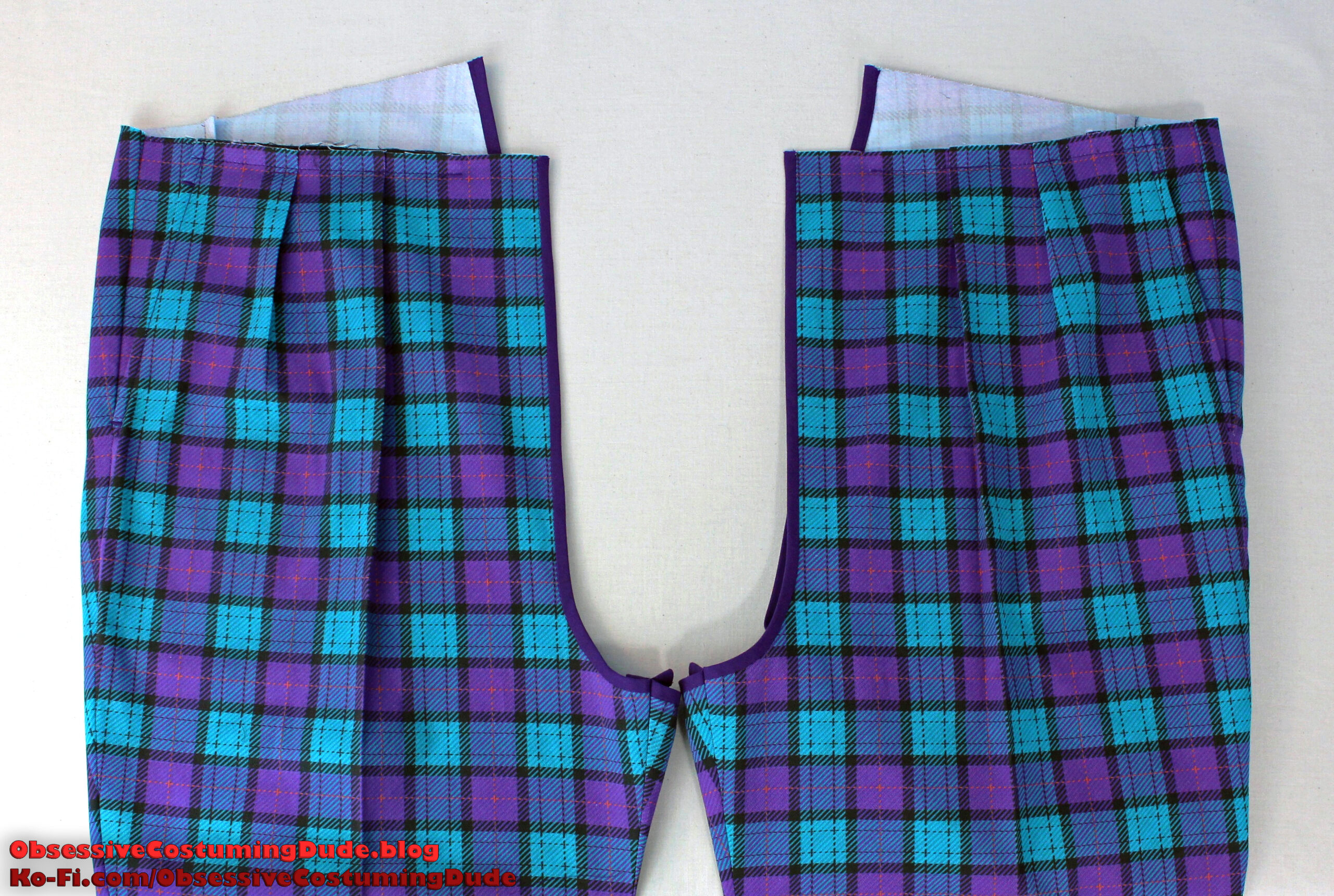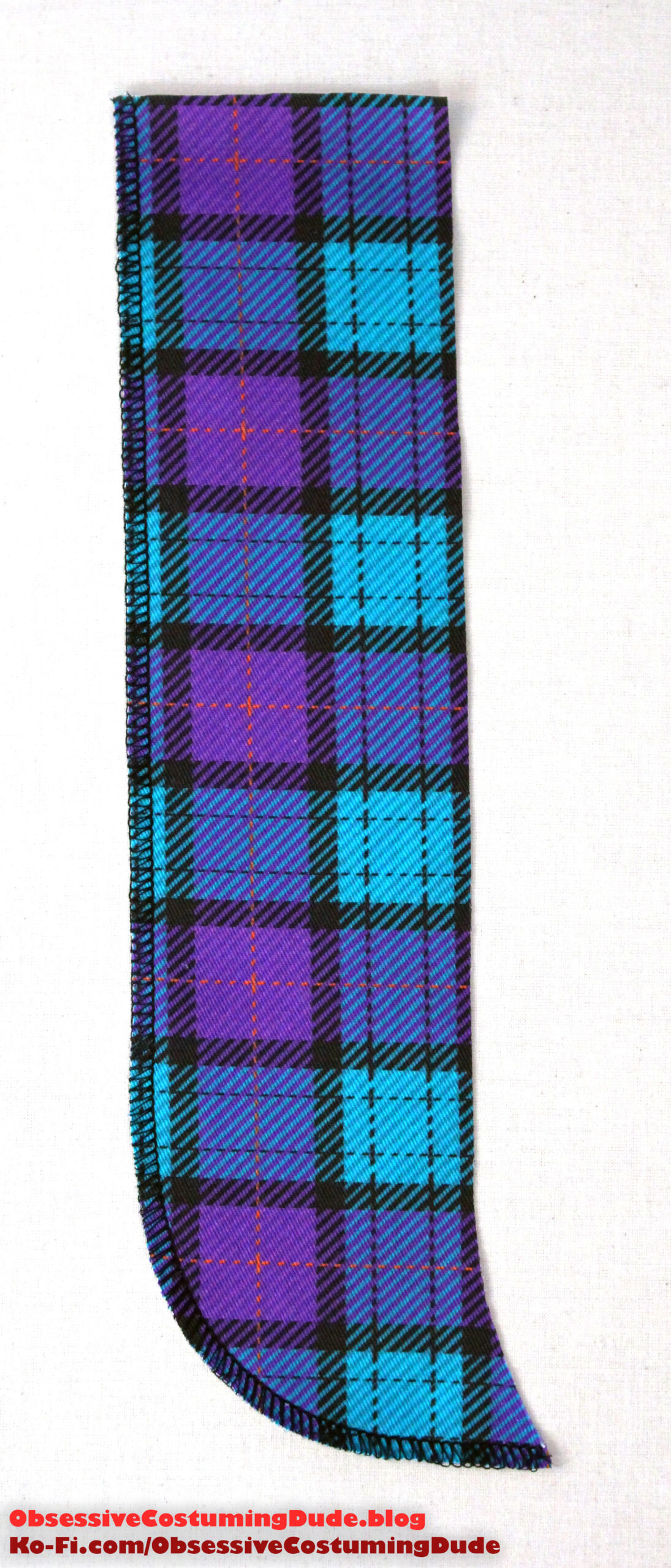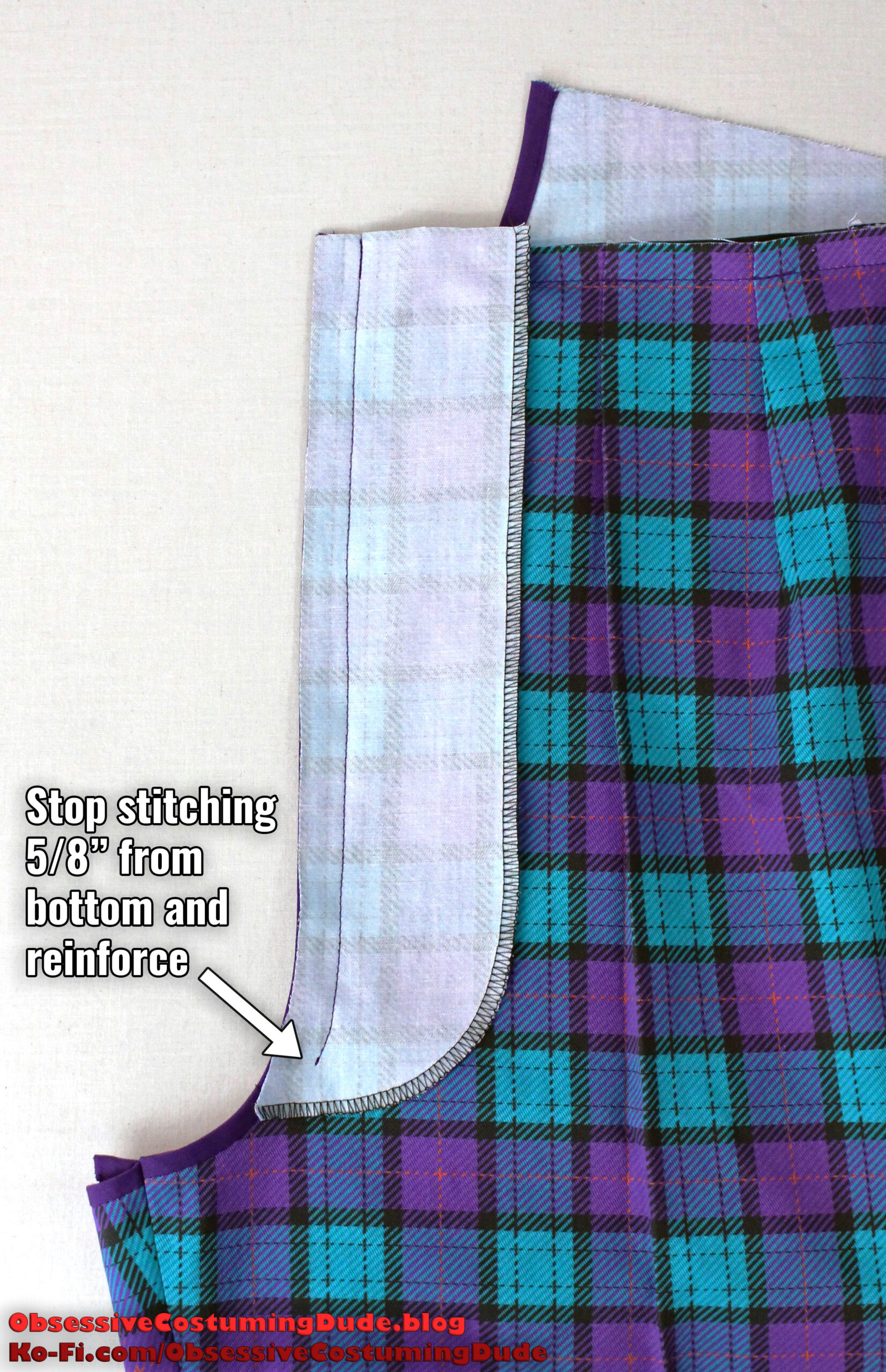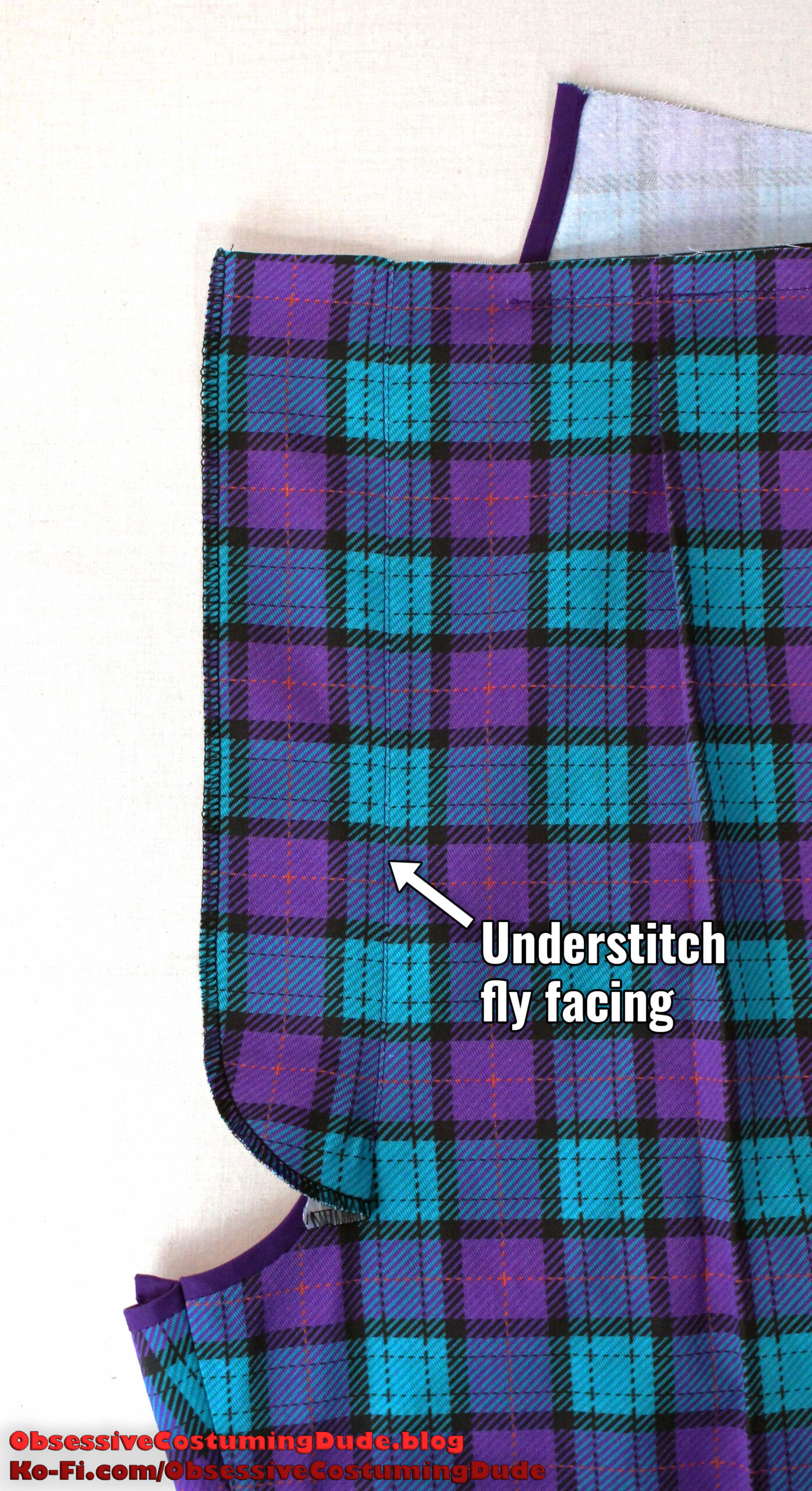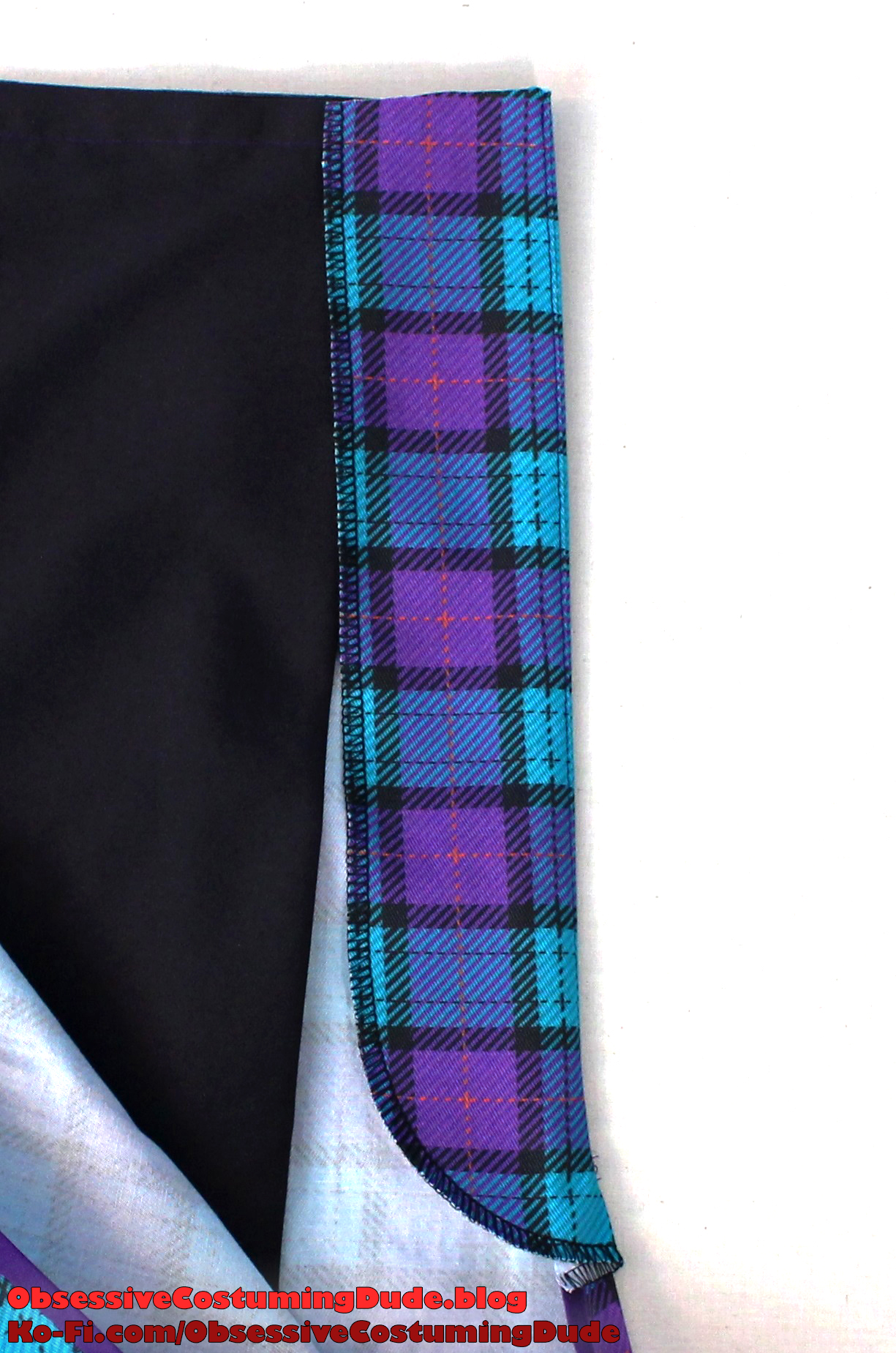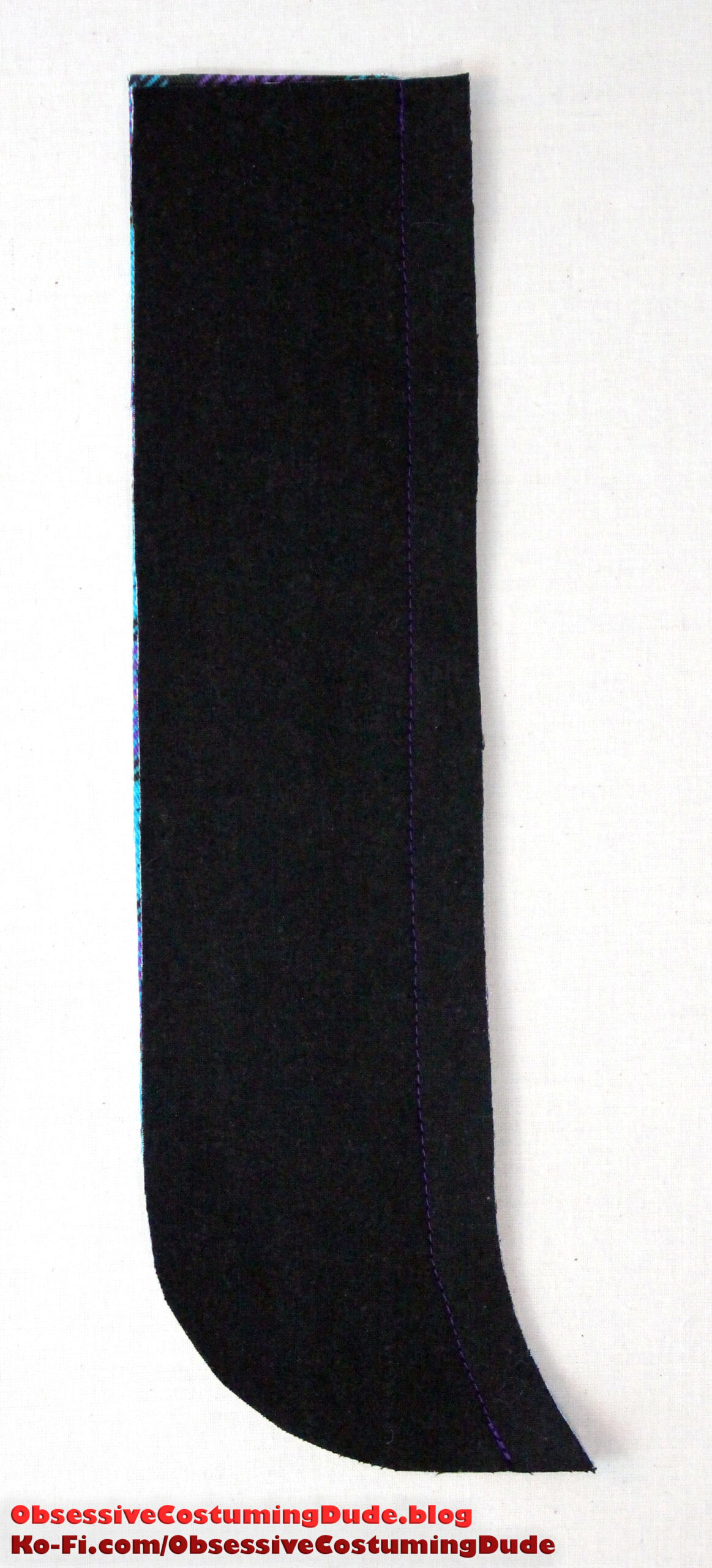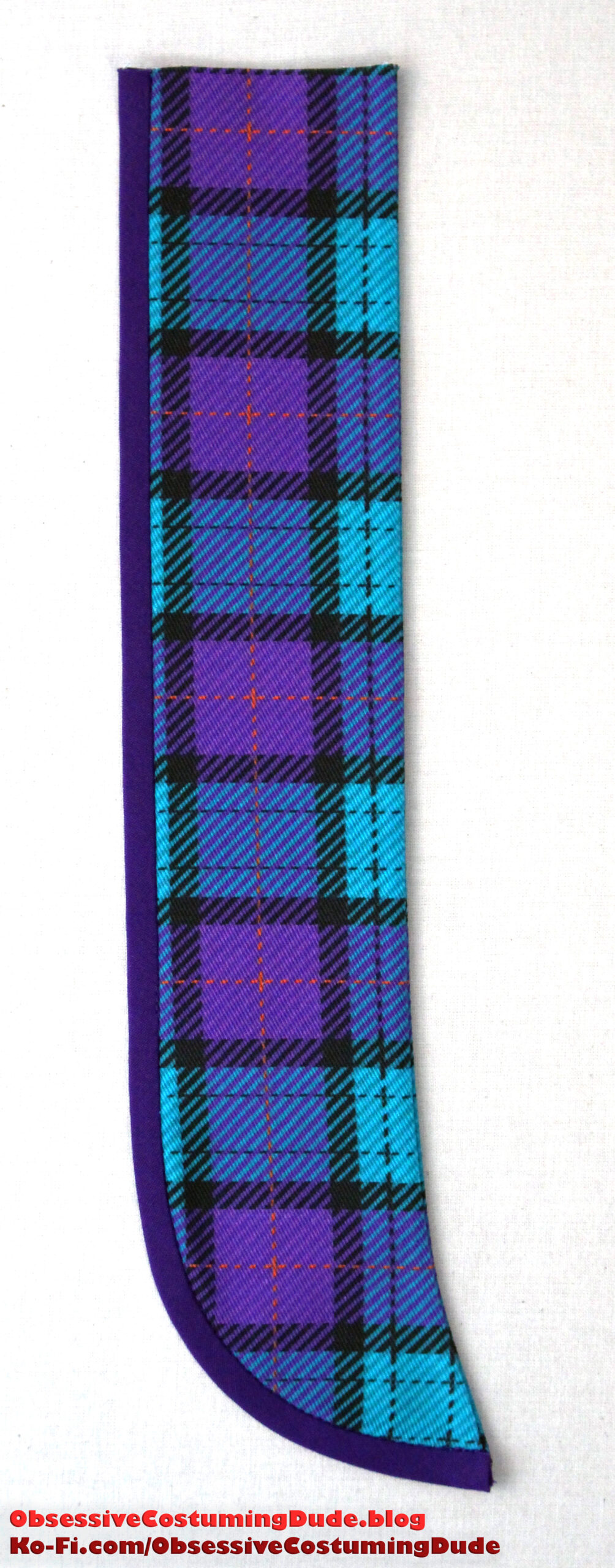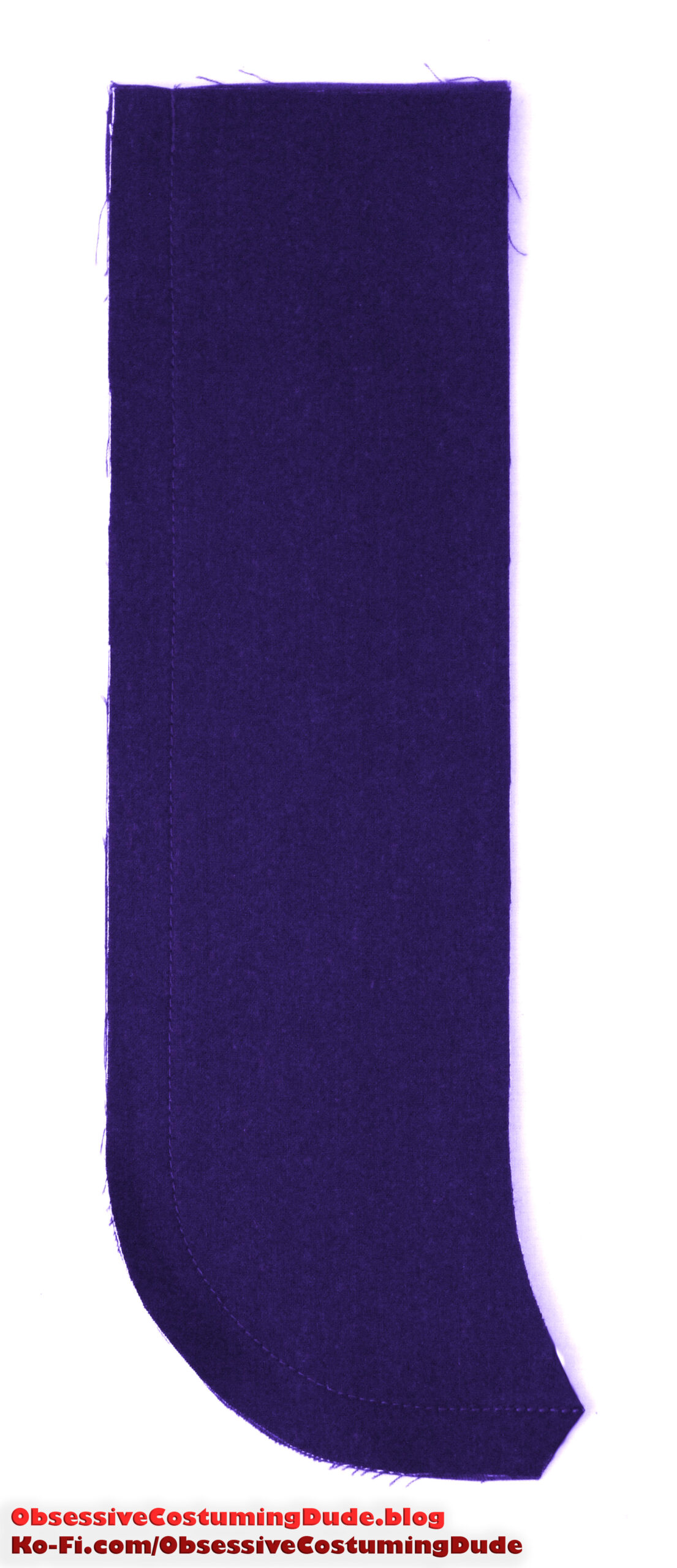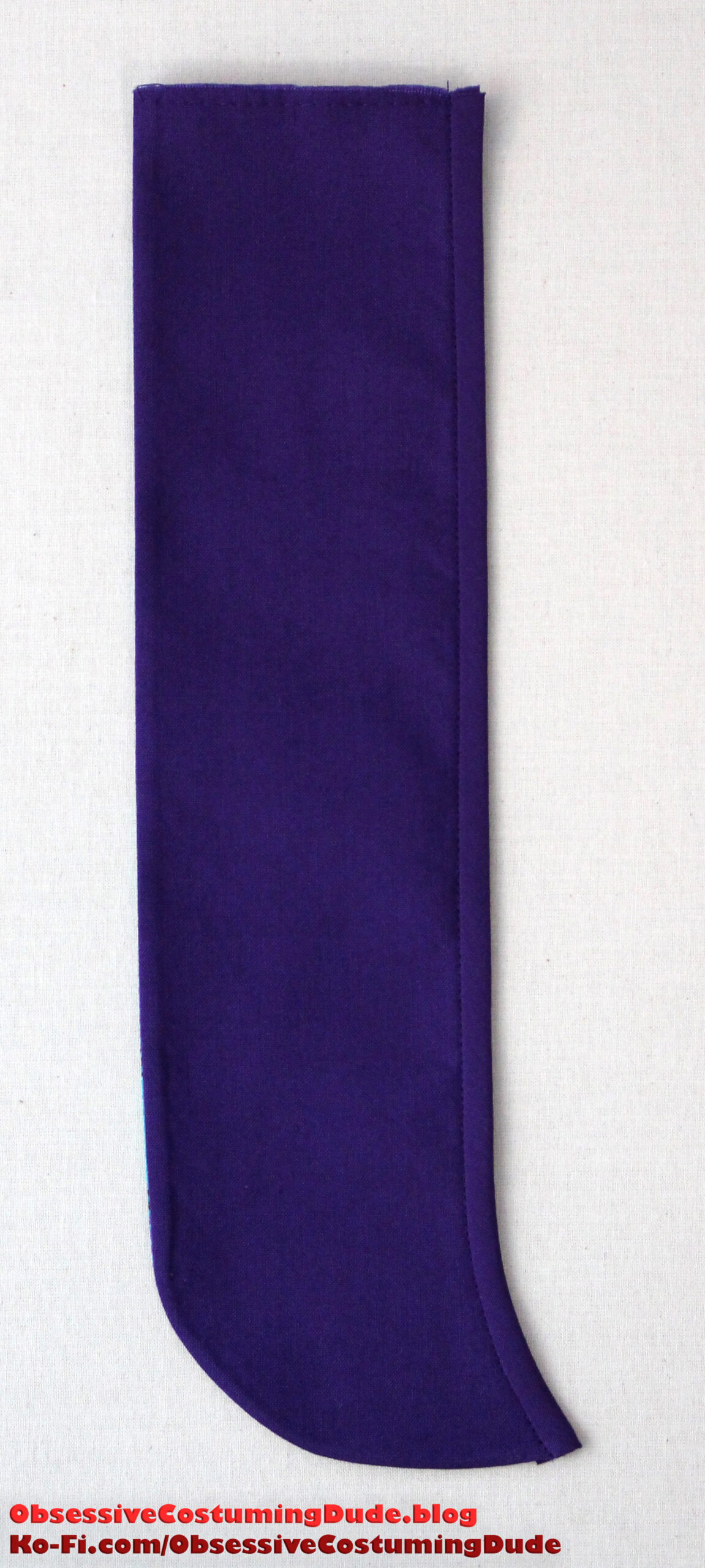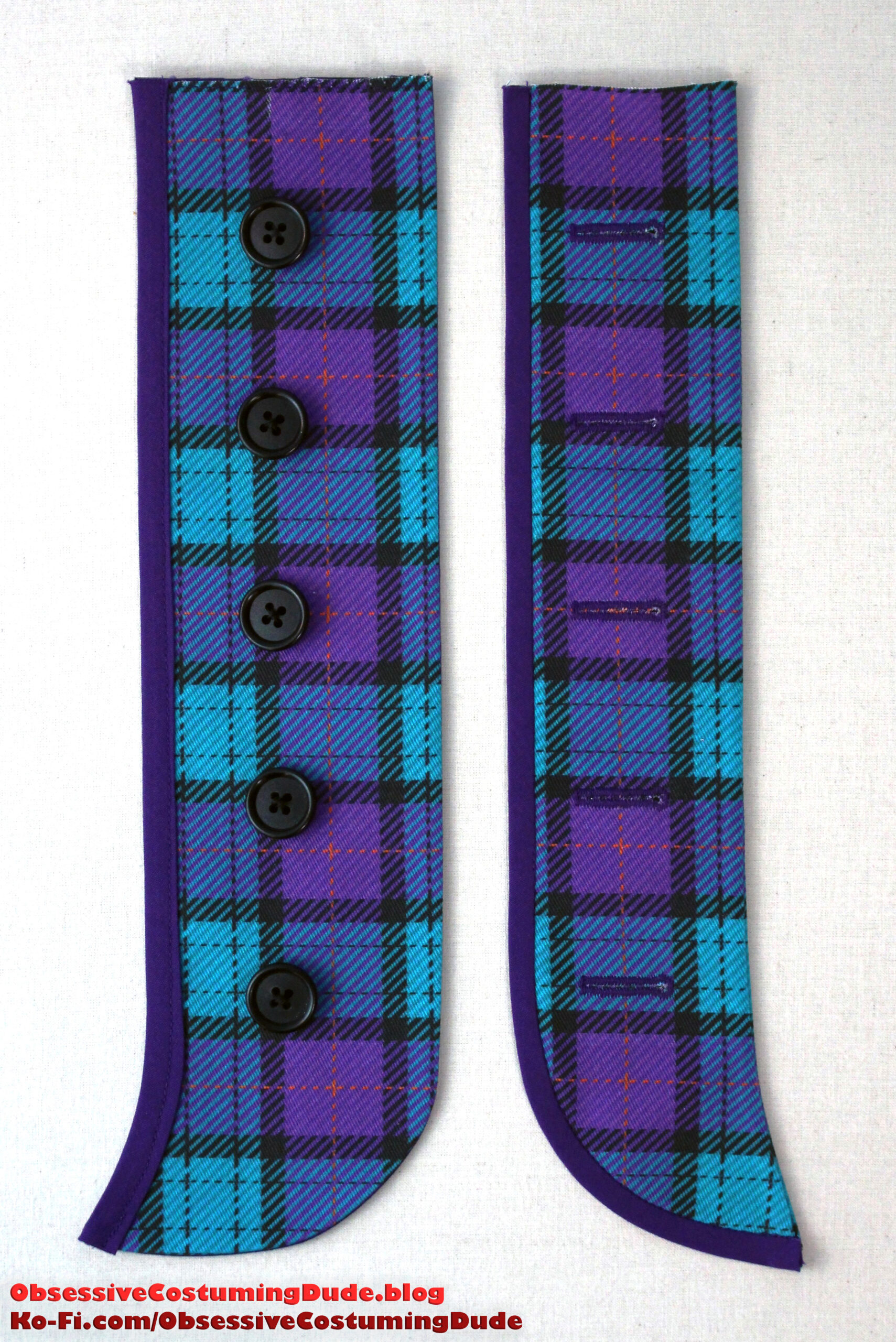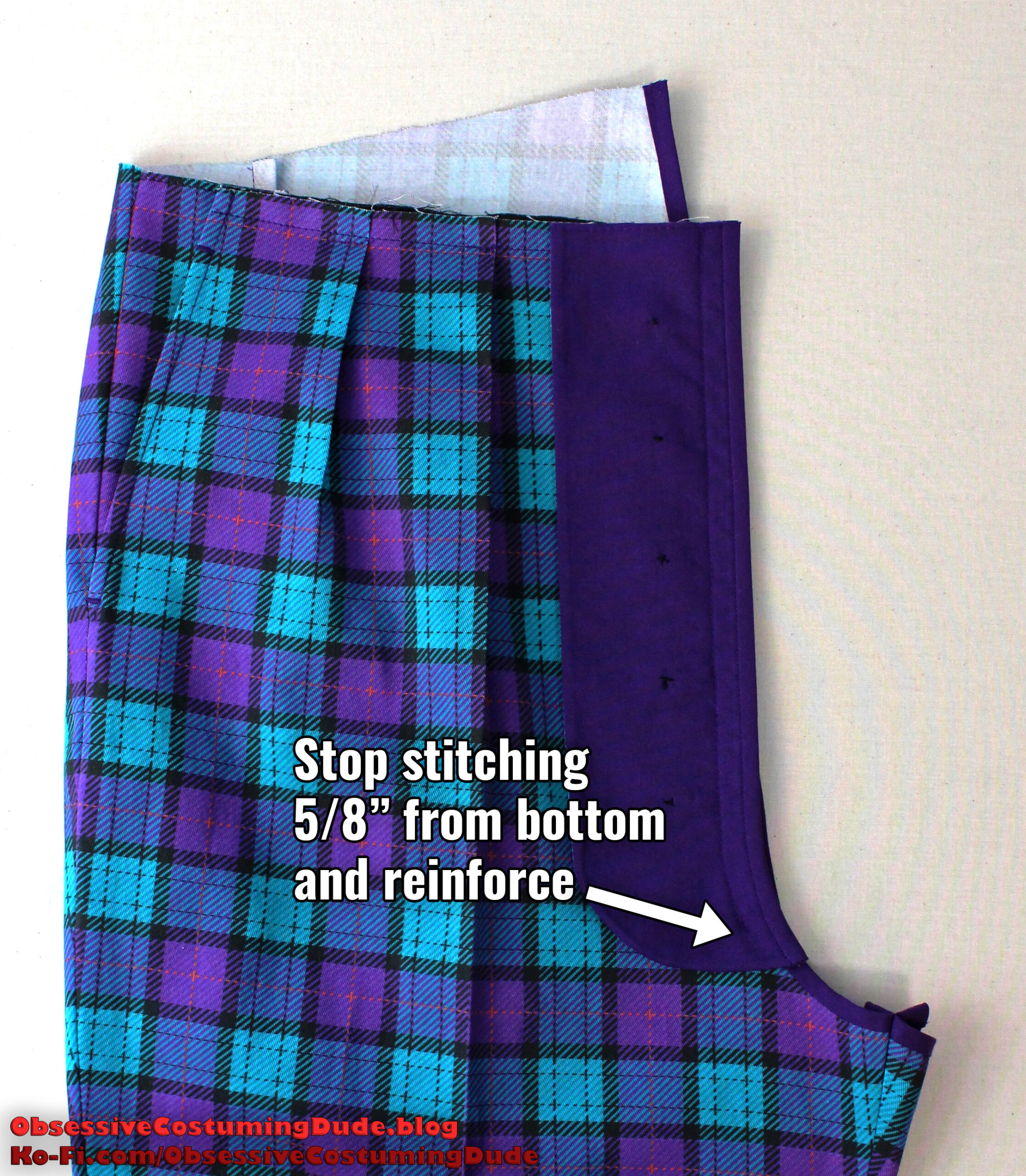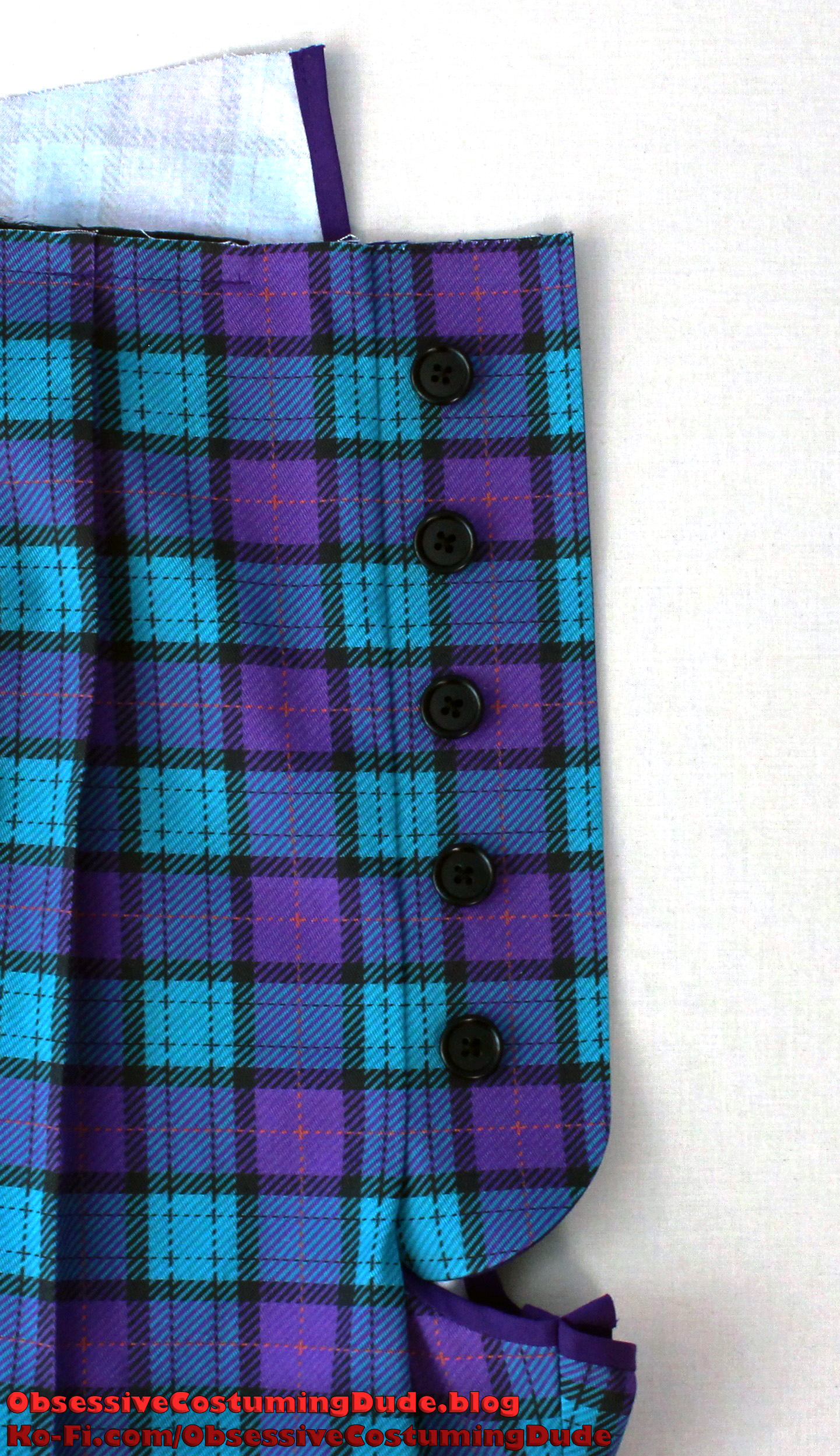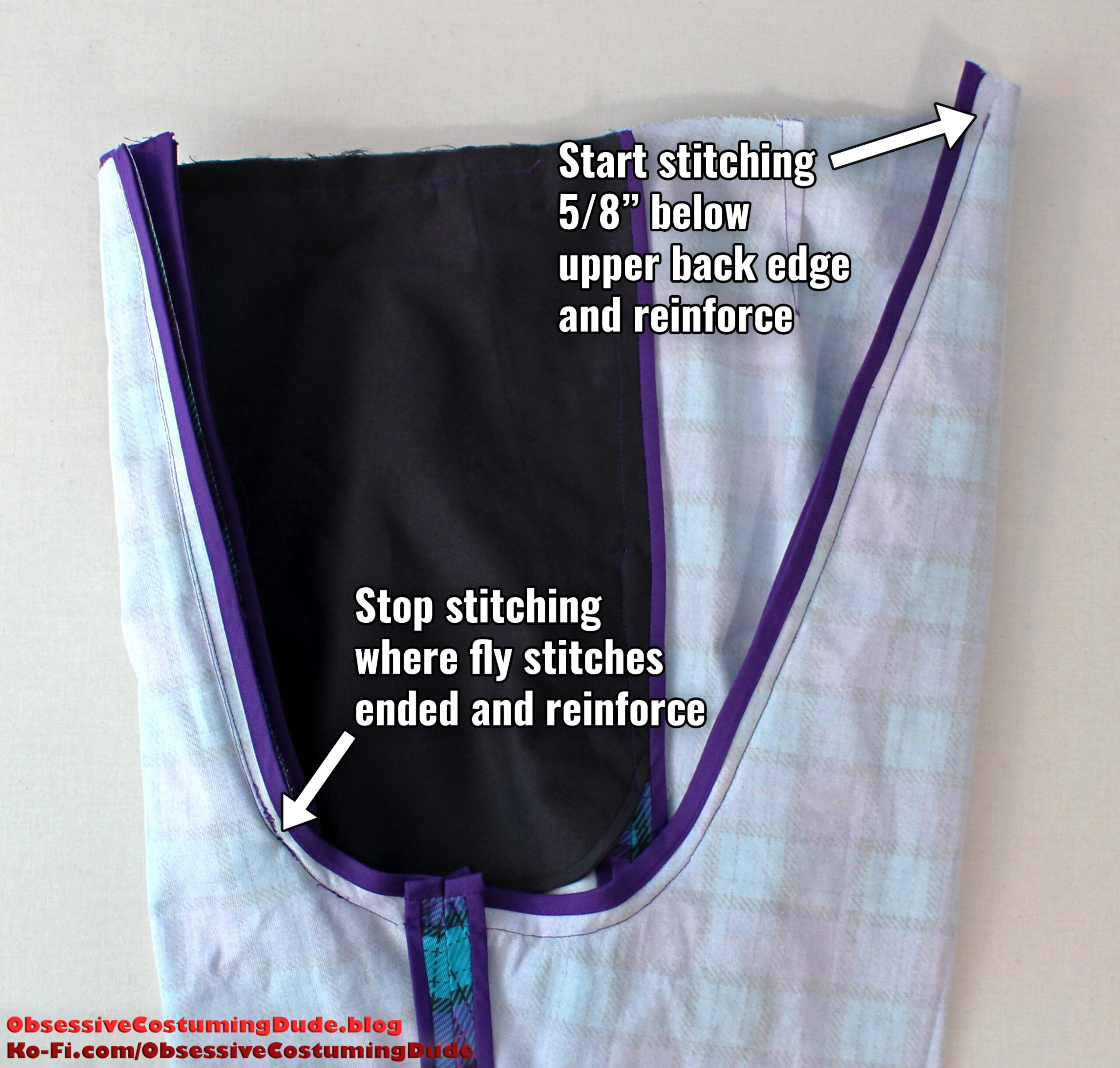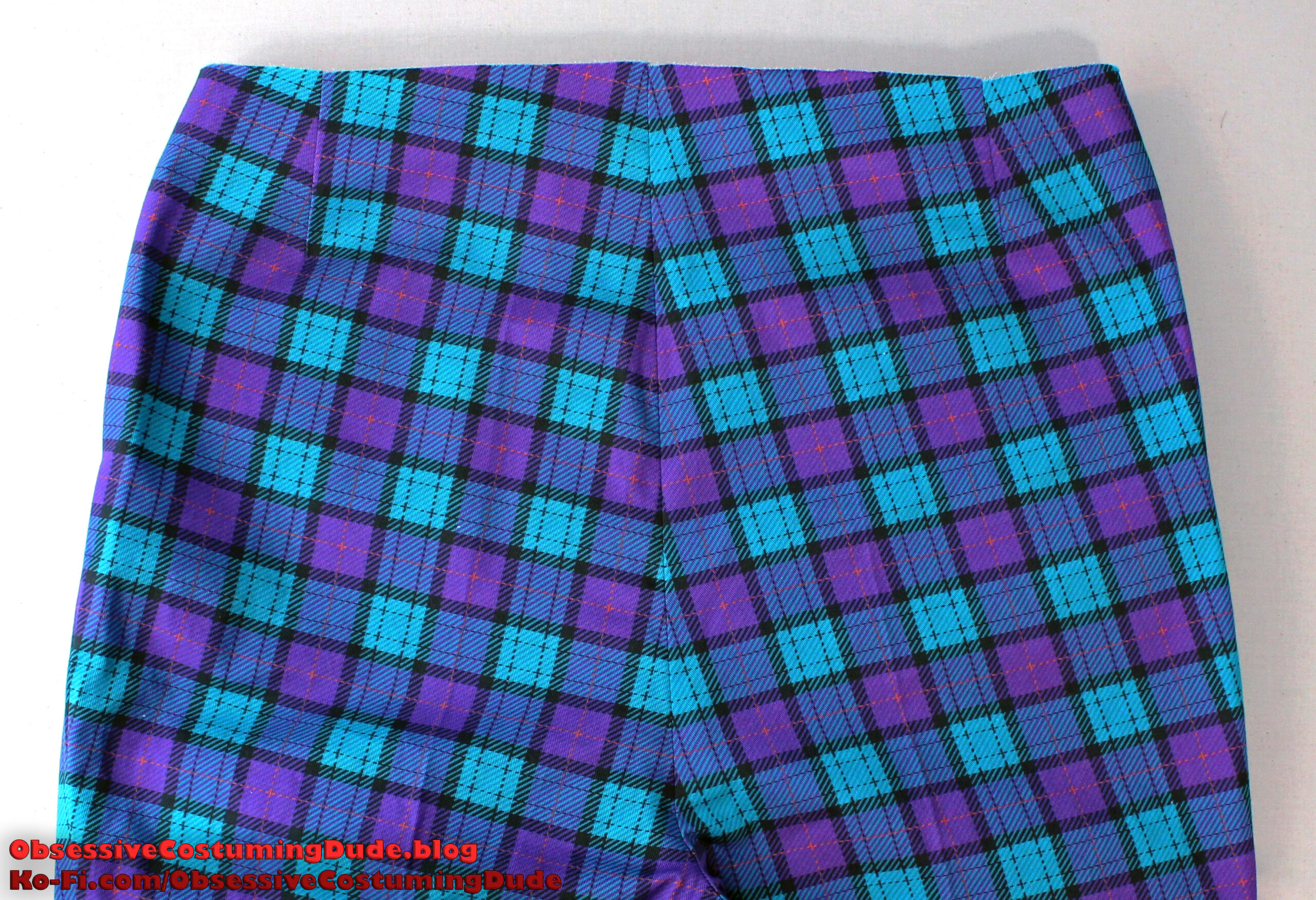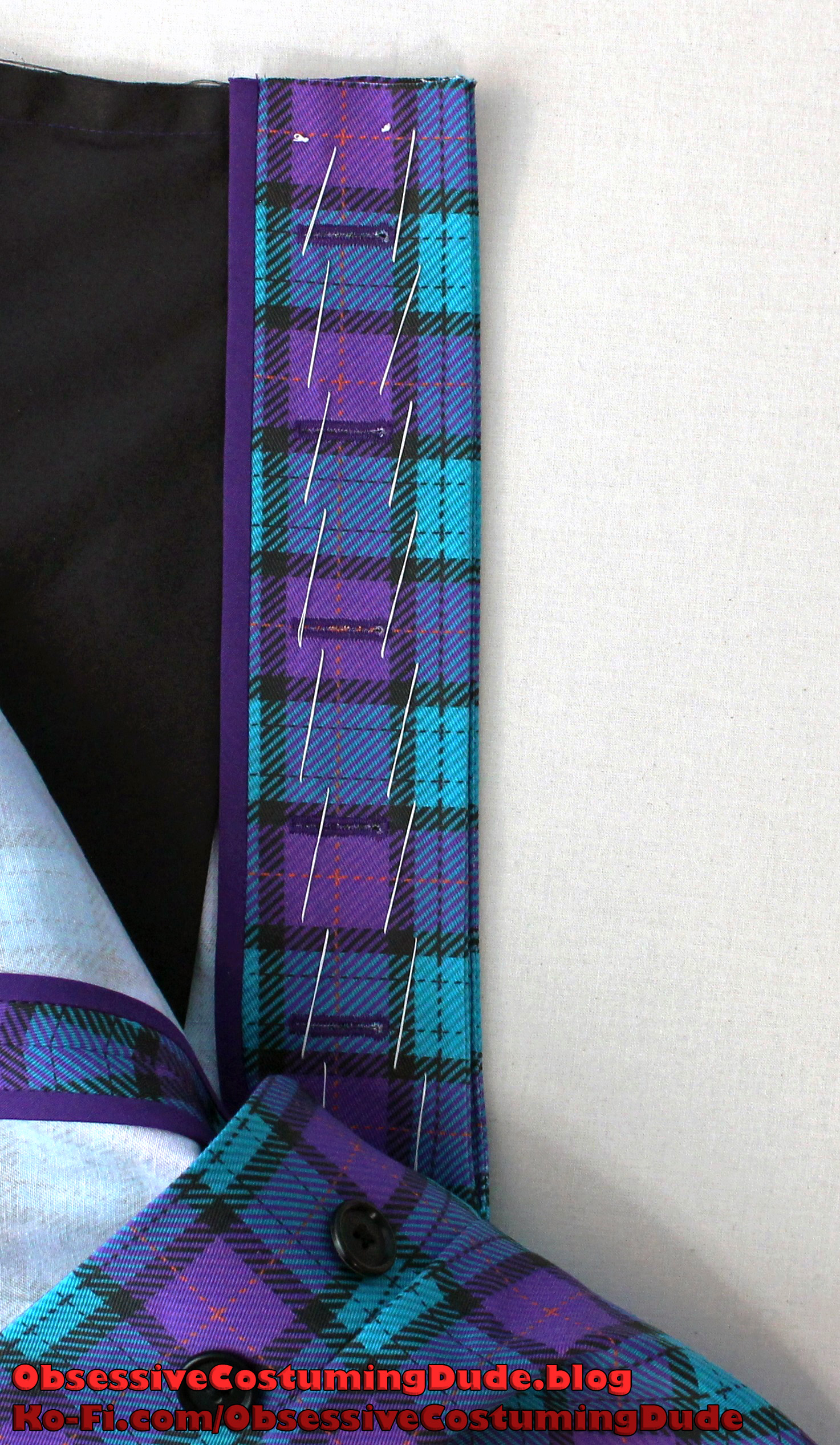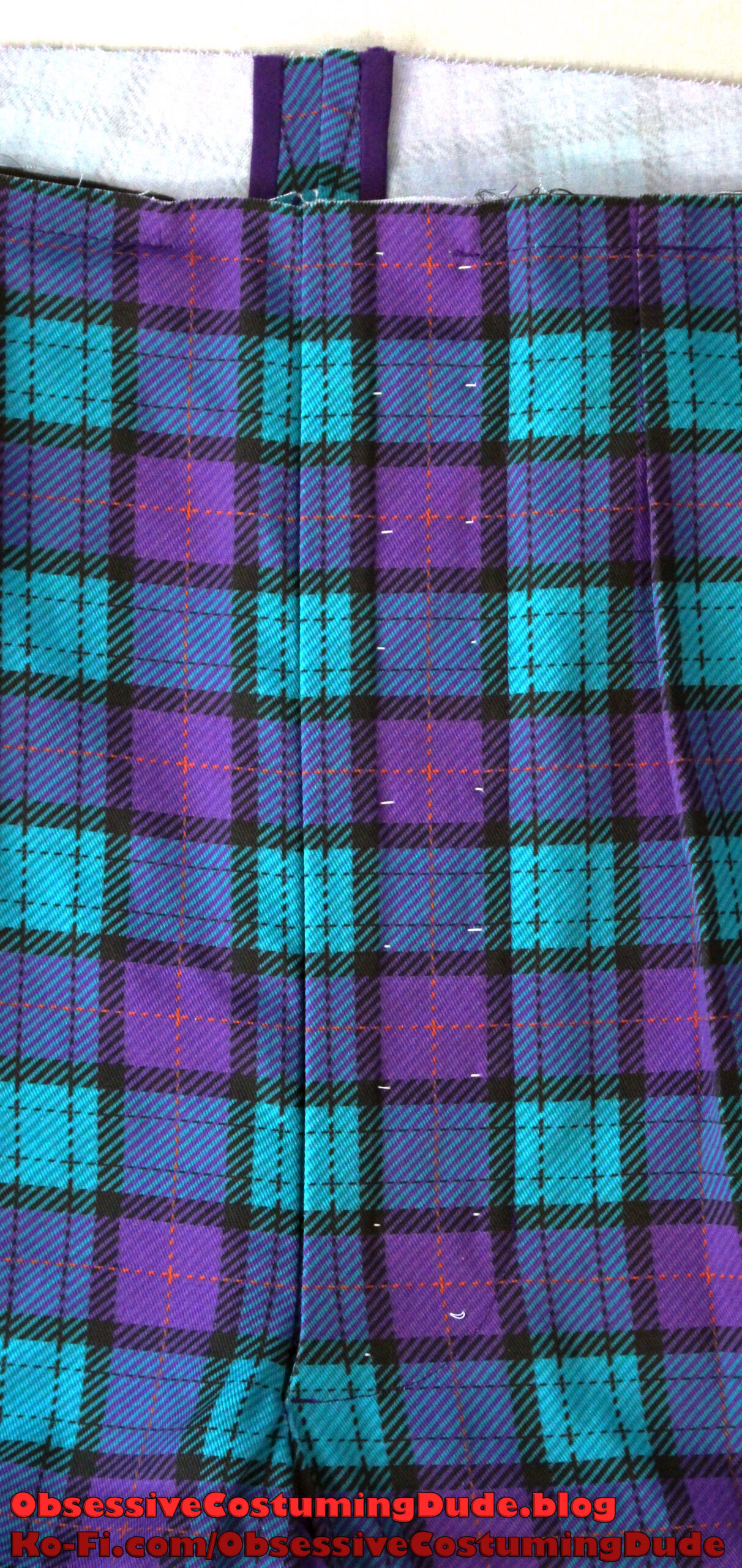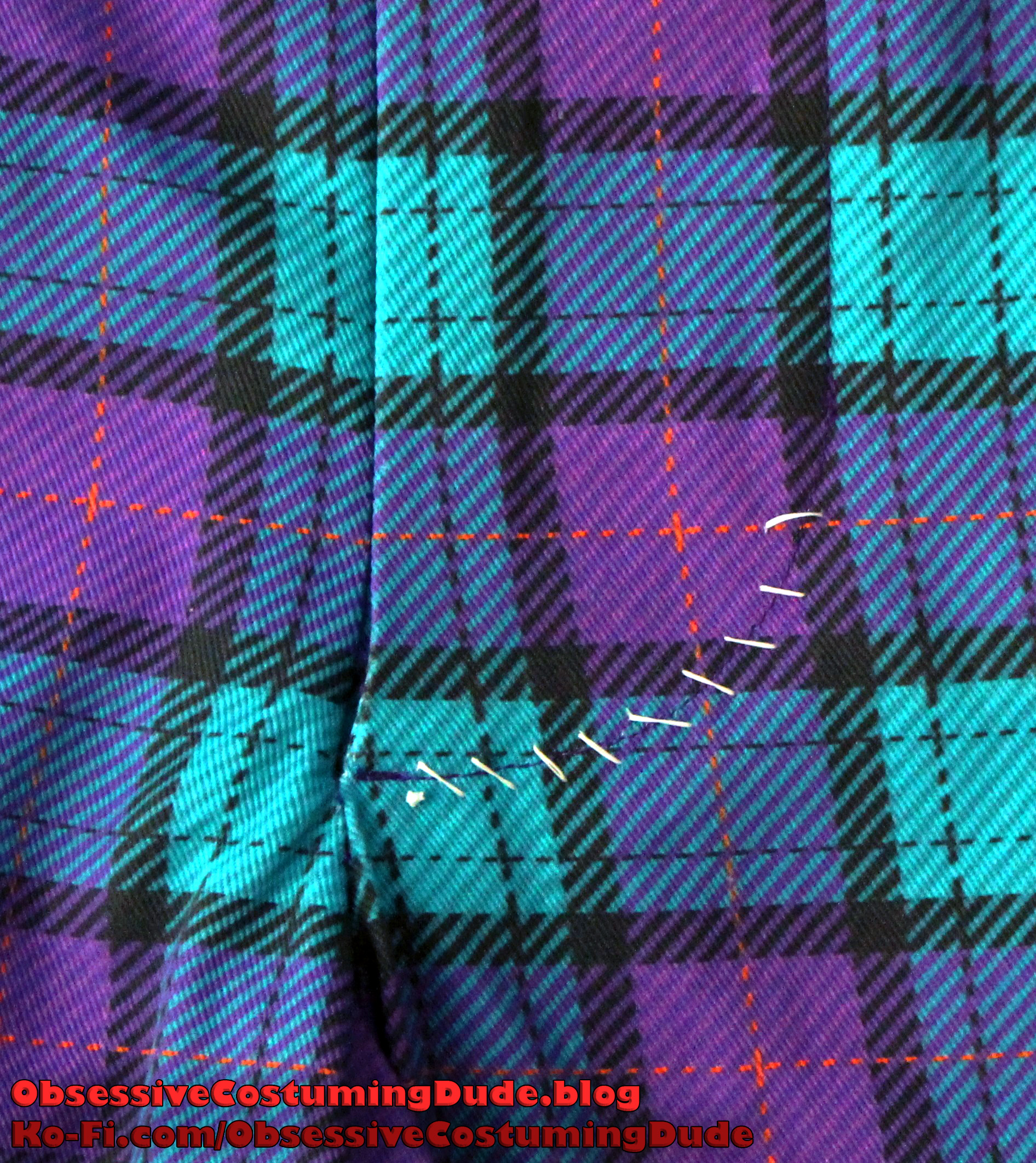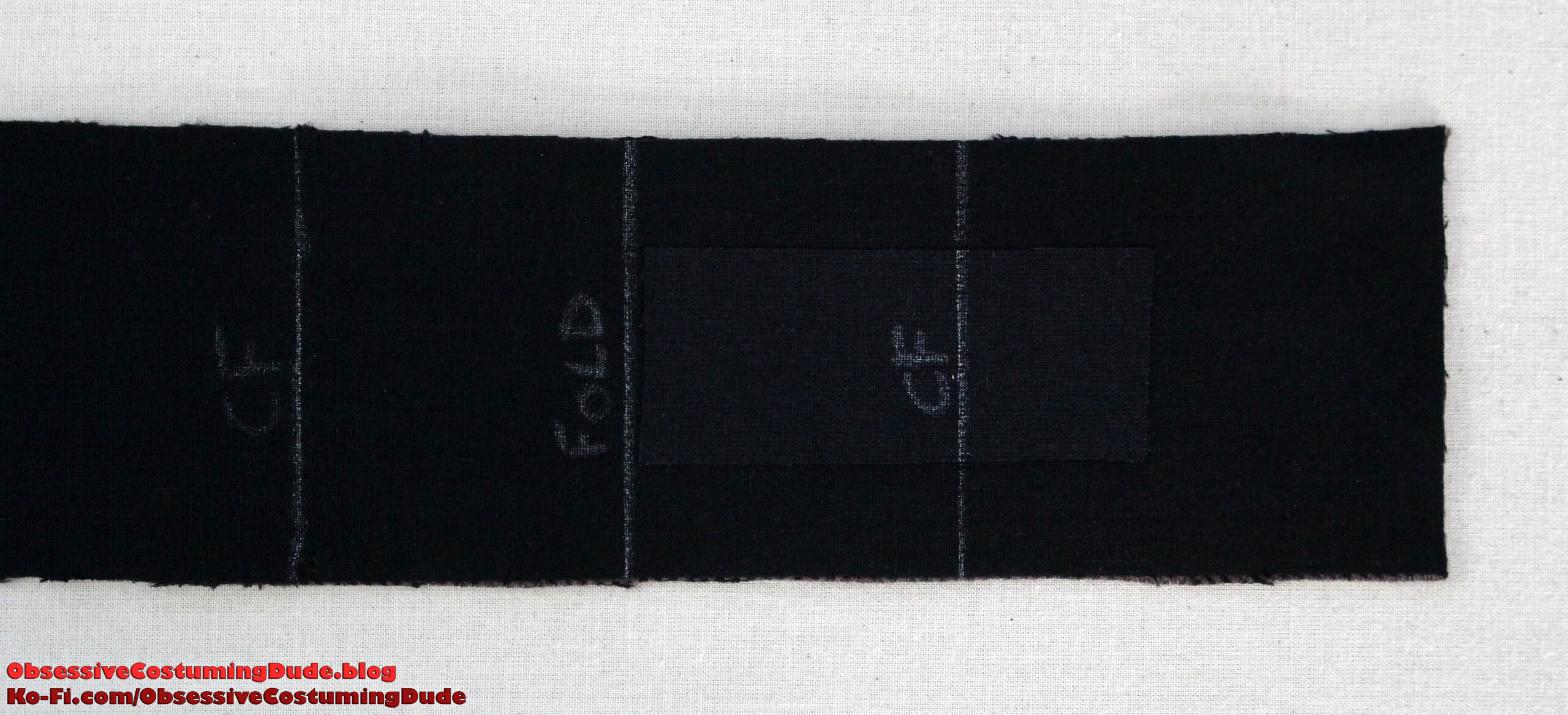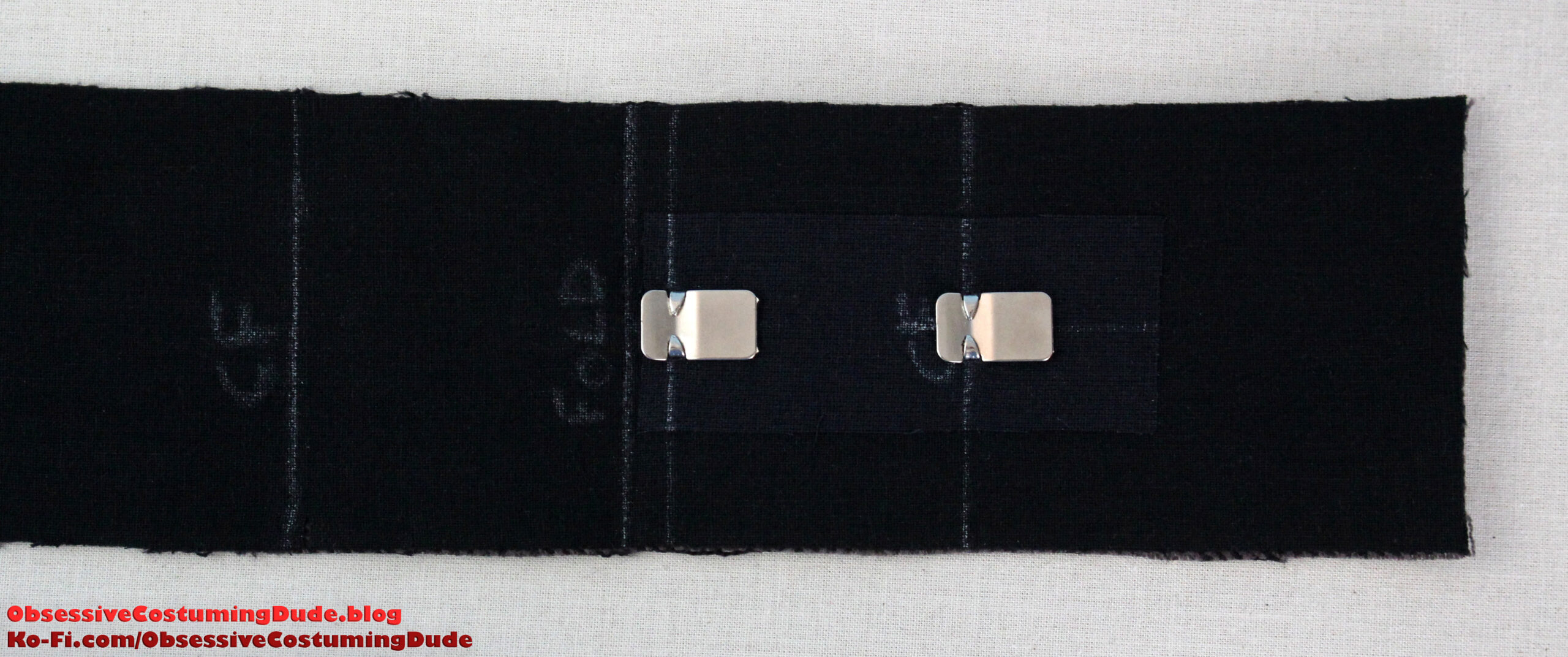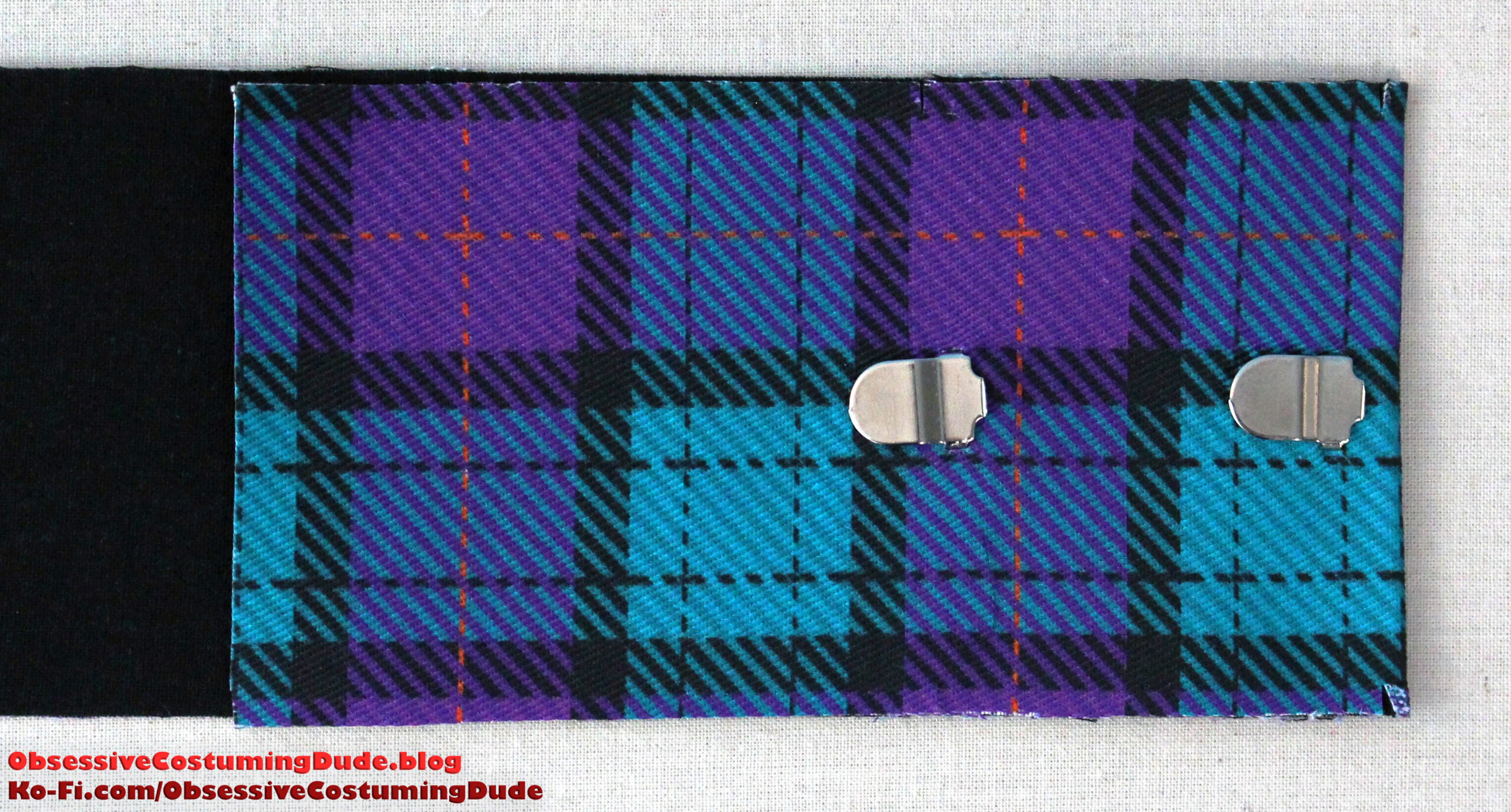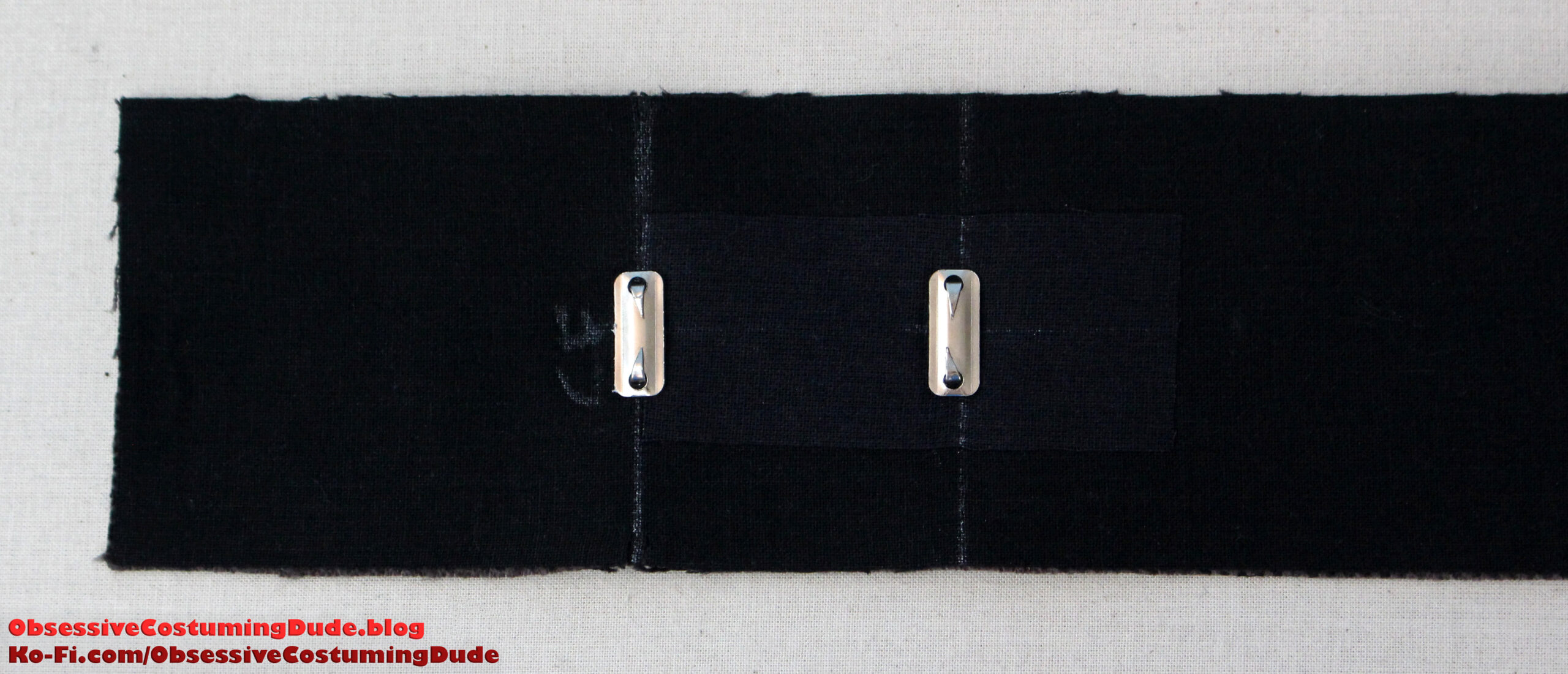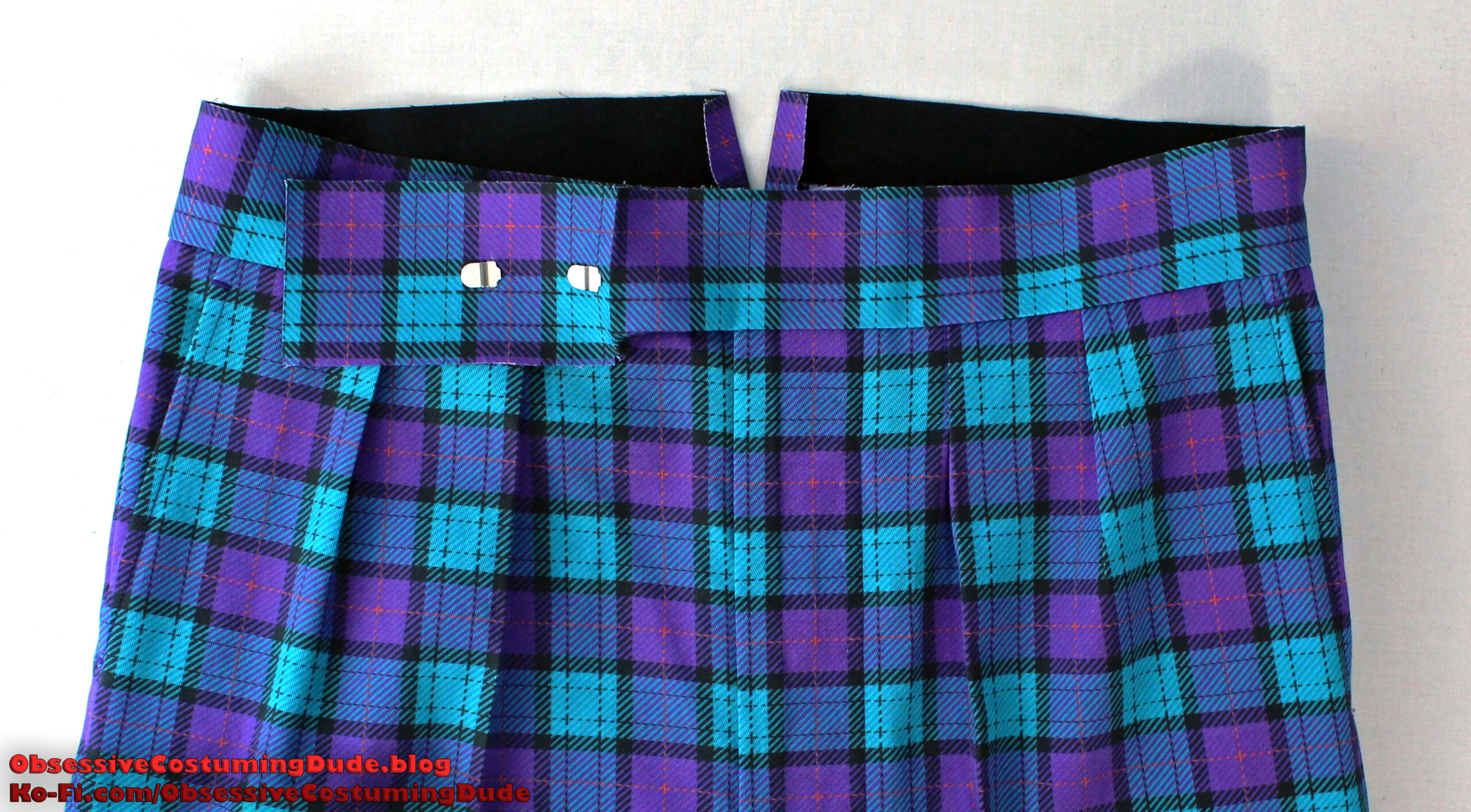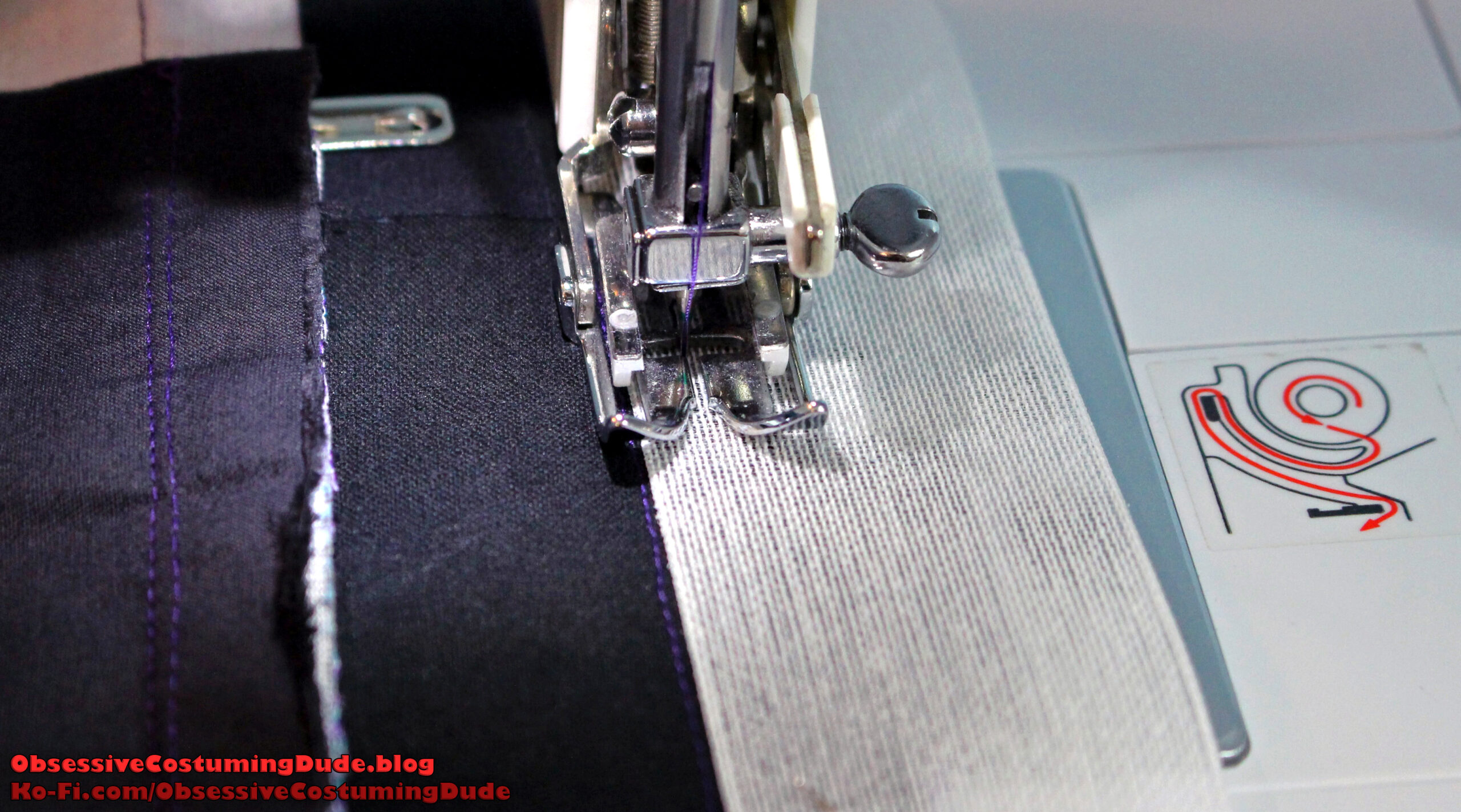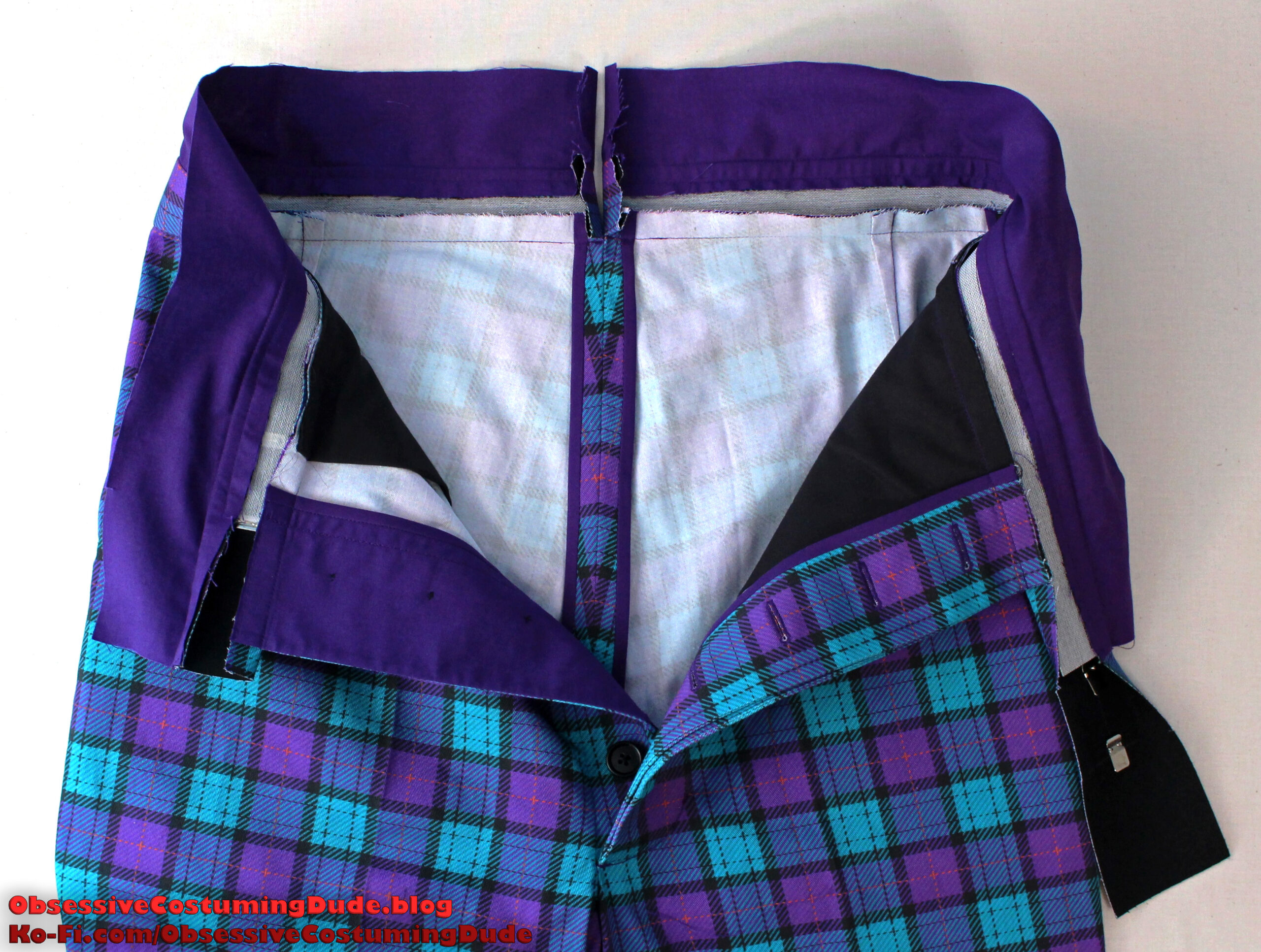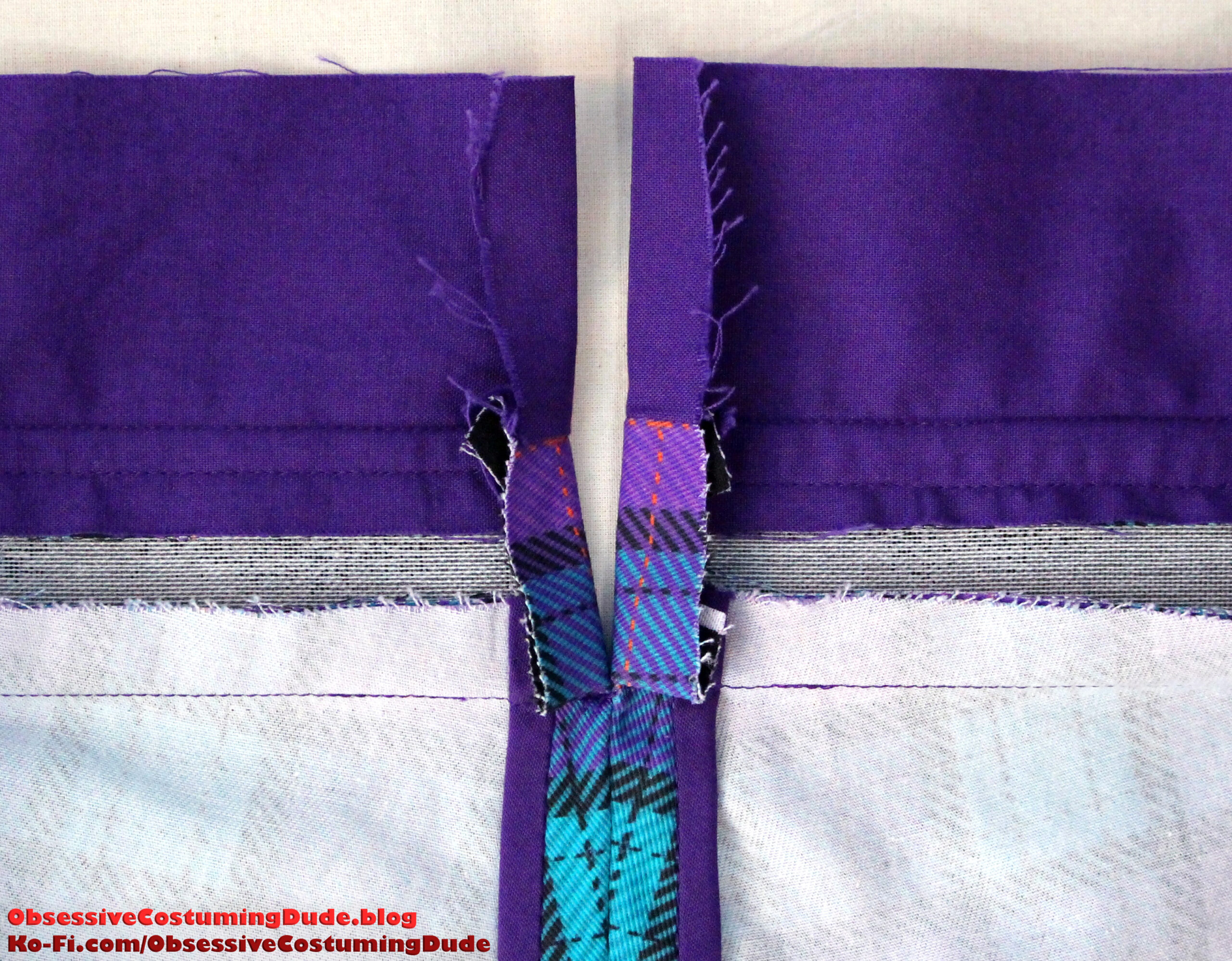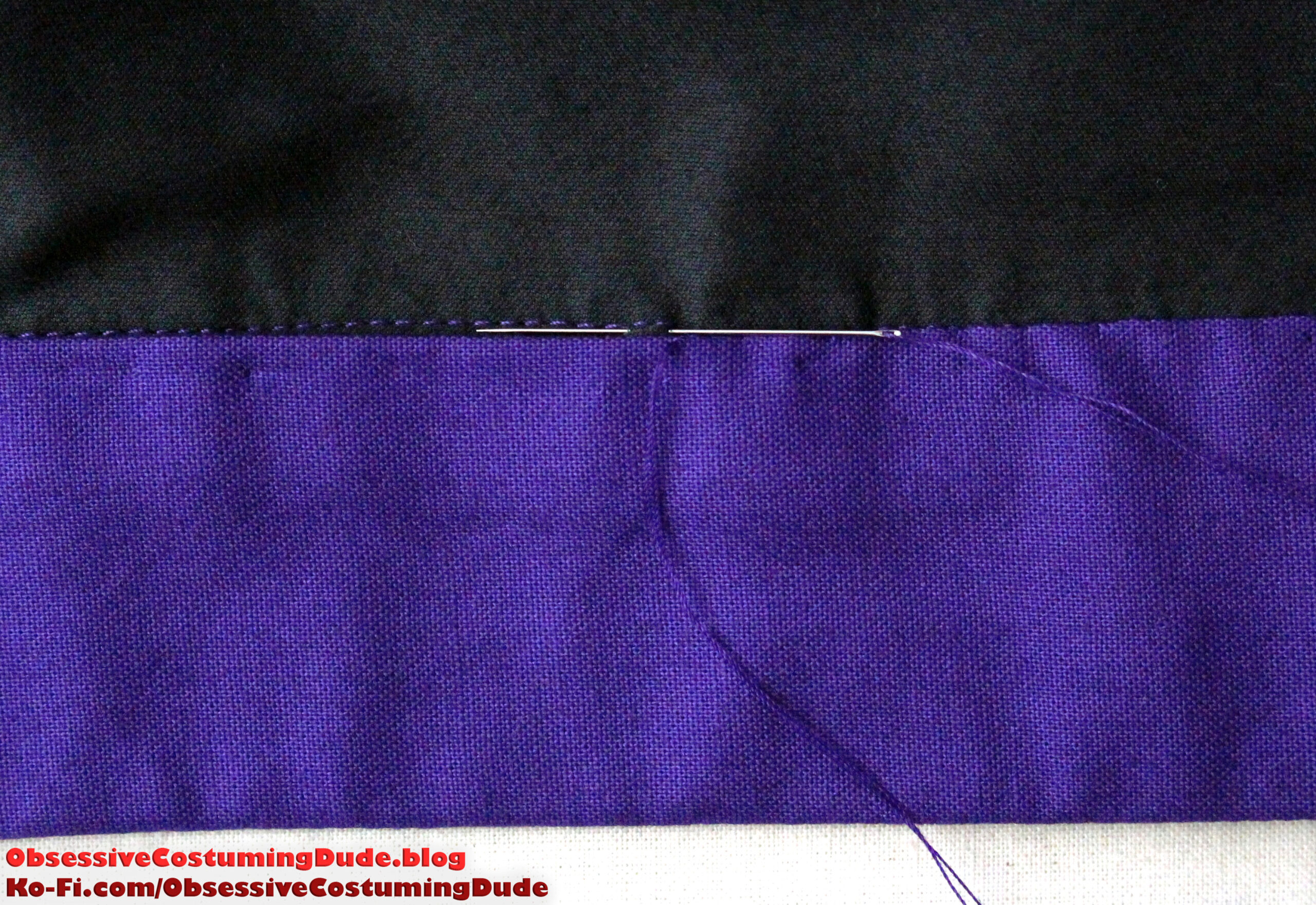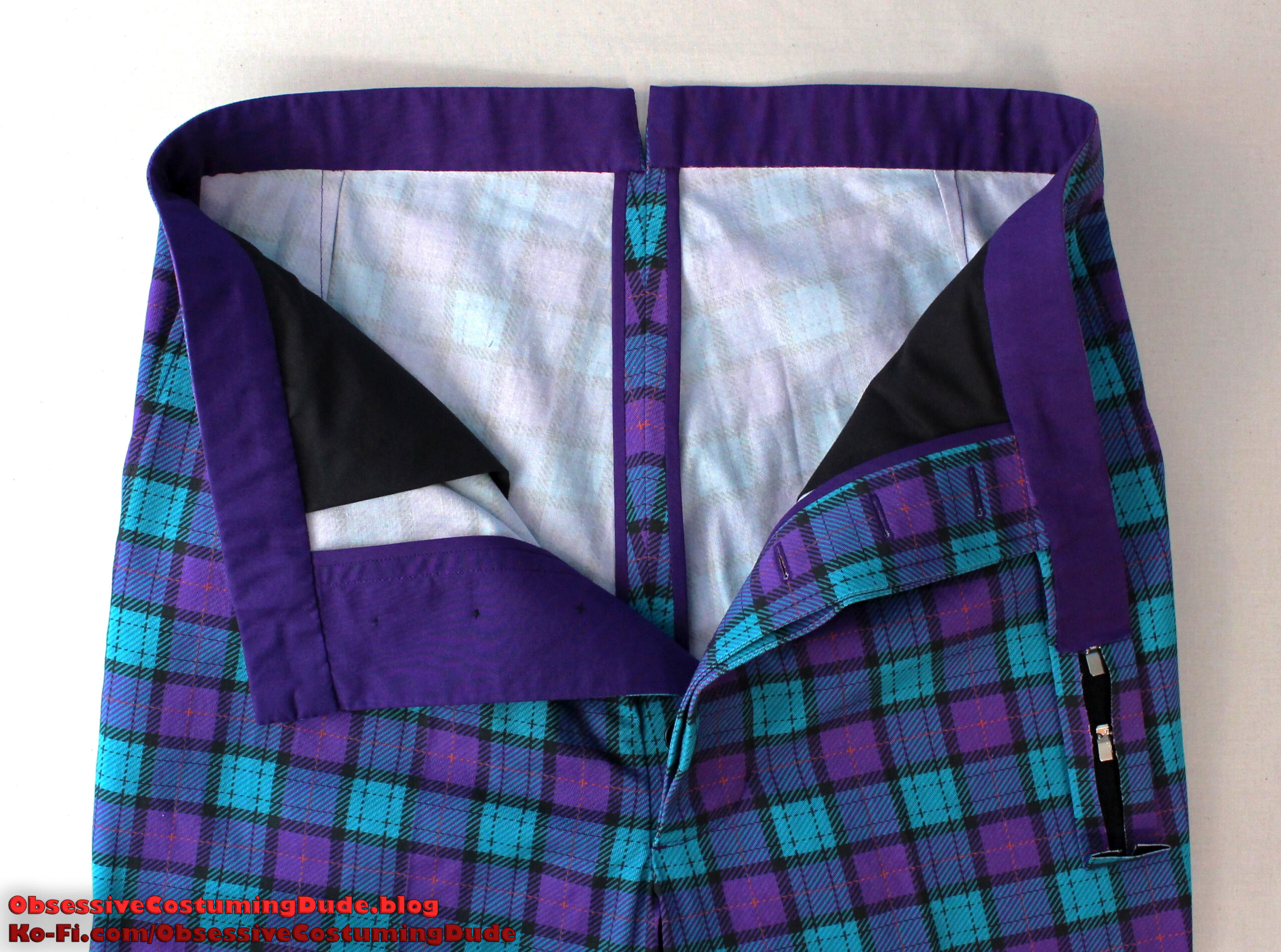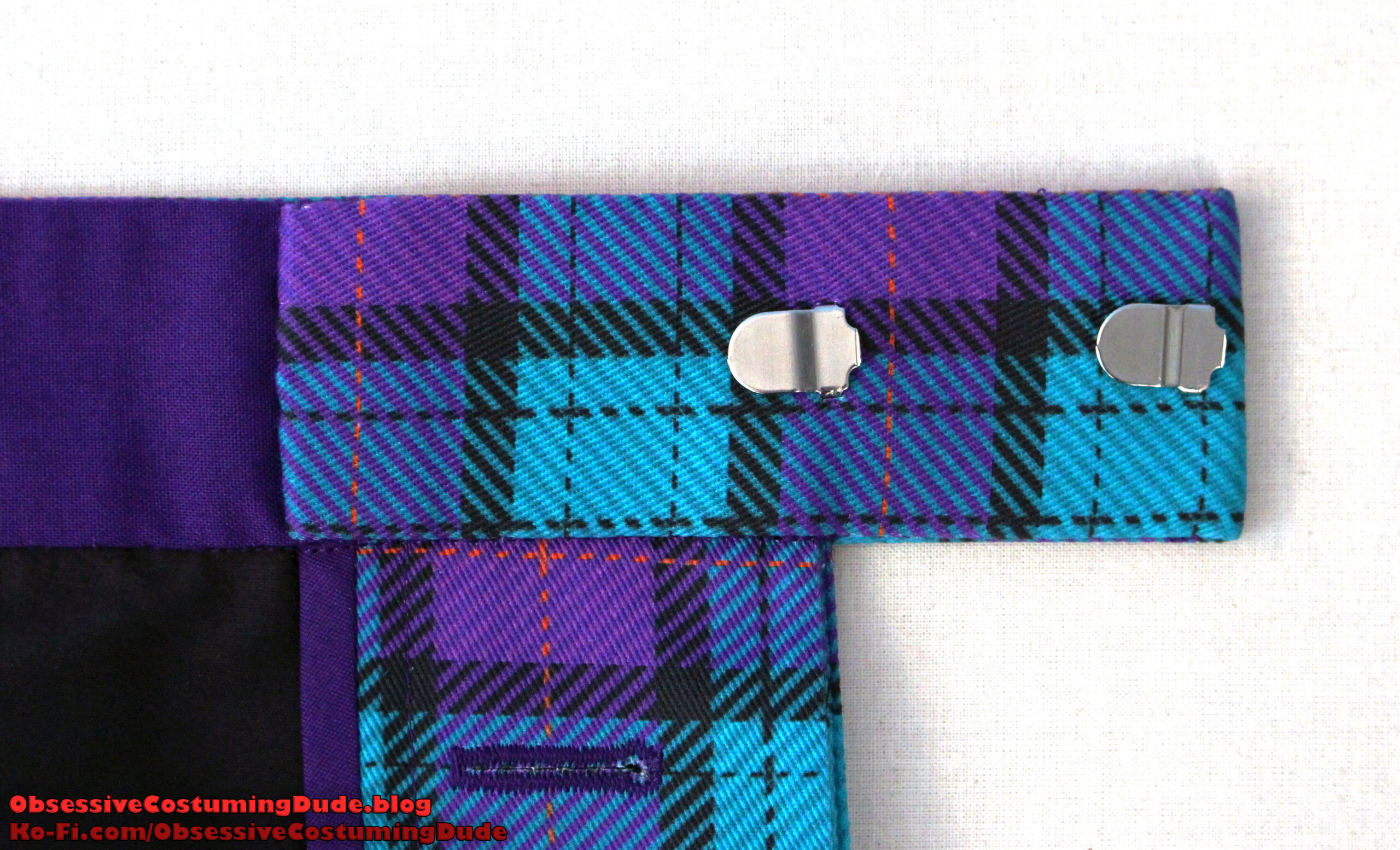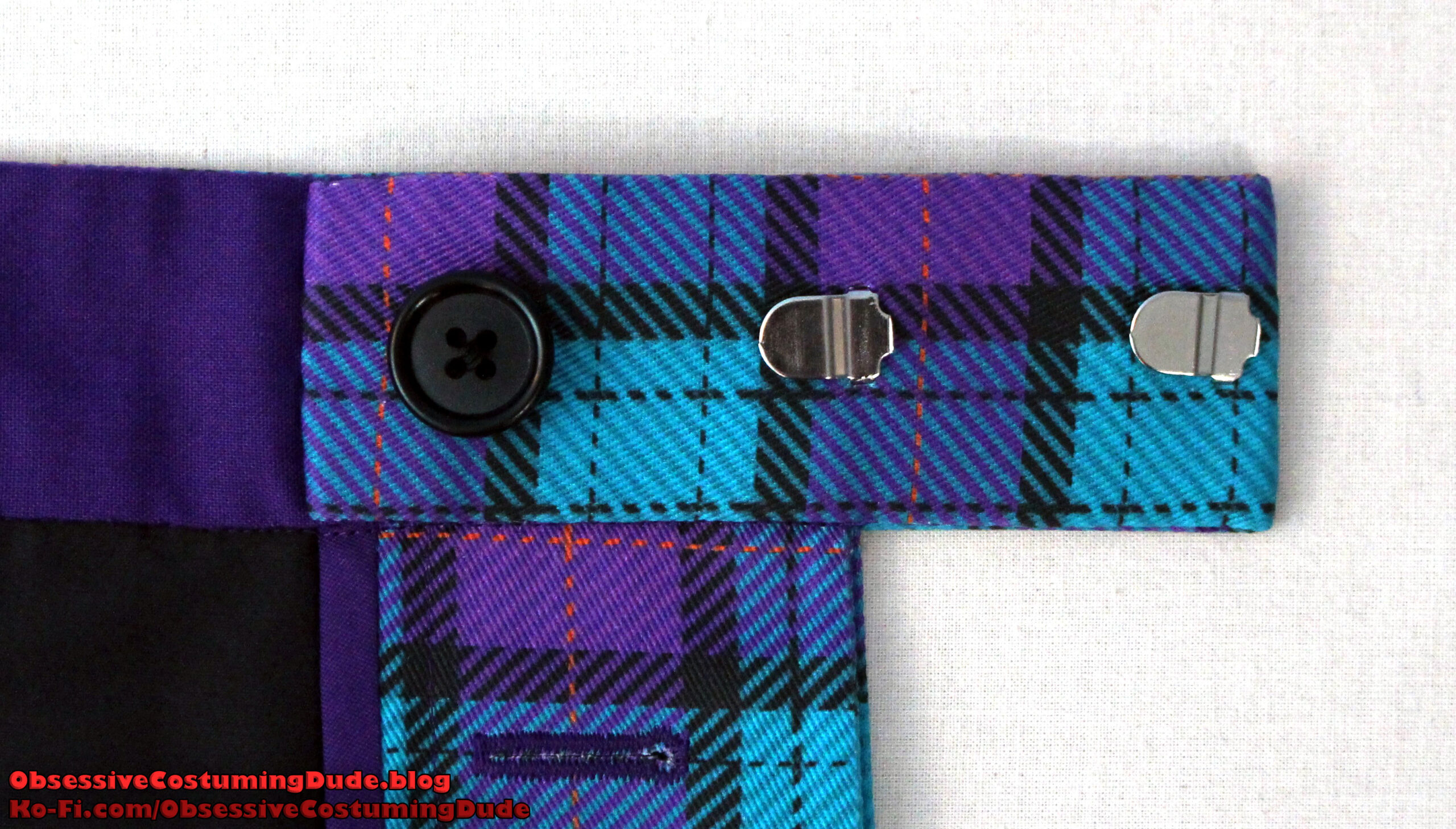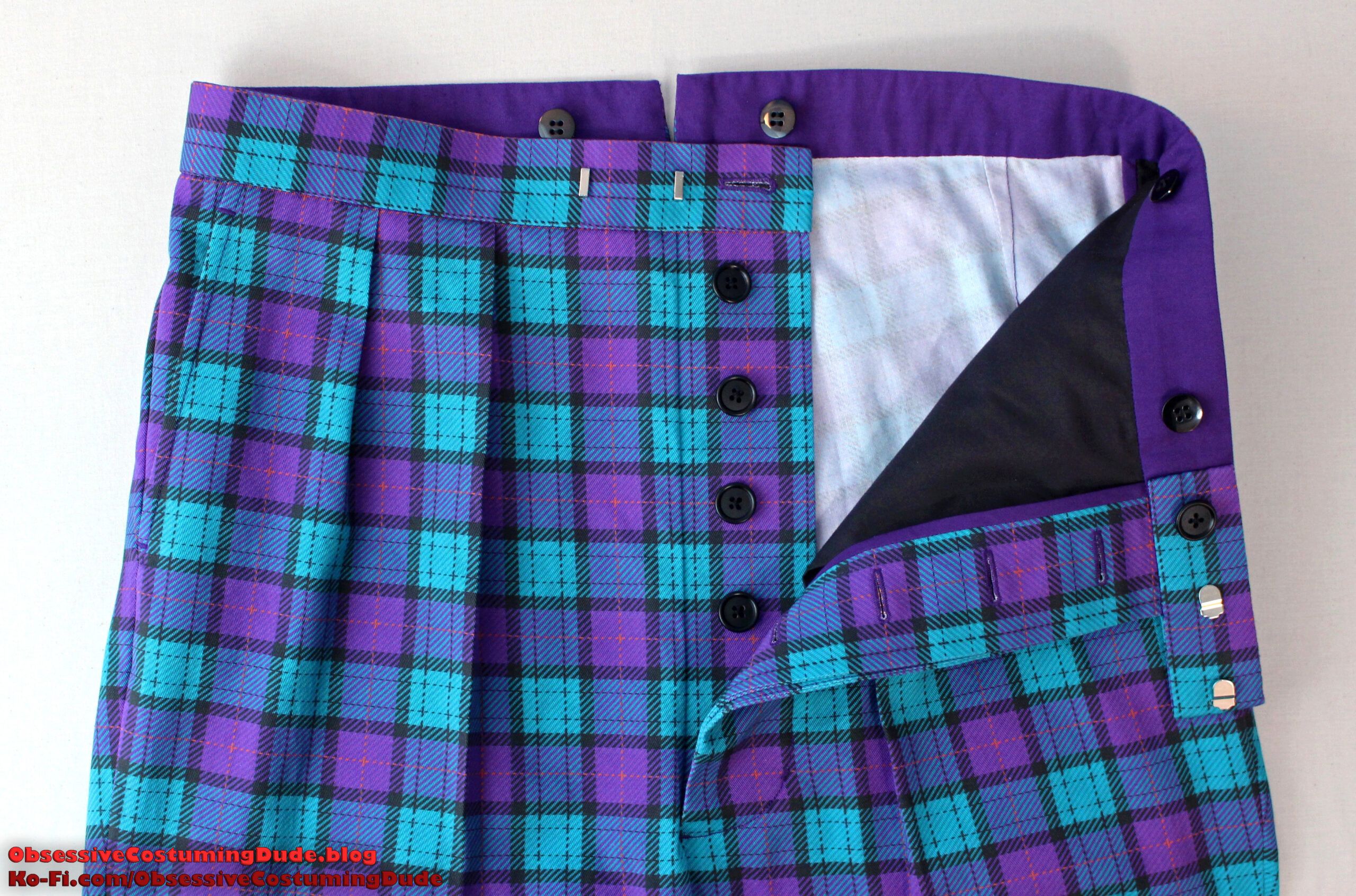ALL SEAM ALLOWANCES ARE ⅝” UNLESS OTHERWISE SPECIFIED!
When cutting out your pattern pieces, pay close attention to the grain line markings in relation to the fabric’s plaid pattern. You can also use the lengthen/shorten lines as horizontal alignment guides to ensure the trousers panels are all properly matched and symmetrical.
Remember to cut your fly and pocket pieces so they properly match the plaid pattern as well. (There are additional alignment guides for the front pocket opening.)
After you’ve cut your pieces, serge or bind the side, inseam, and center front/crotch edges of the front panels (piece A). Do not serge or bind the diagonal edge where the pocket will be installed.
Serging is definitely easier, but as I mentioned in the “Required Materials,” I chose to bind the interior edges of my trousers just to make them more fun. 🙂
On the back panels (piece B), serge or bind the inseam and center back/crotch edges, but not the outer side edge. (This will be done when finishing the pockets.)
Press under ¼” on the diagonal and lower edges of the pocket facing (piece E) and pocket yoke (piece F).
Edge-stitch the pocket facing and yoke to their corresponding edges of the pocket bag (piece G), with upper and outer edges flush.
Position the pocket bag assembly underneath the trousers front so the diagonal edge of the pocket facing is flush with the diagonal edge on the pant leg.
Sew the pocket bag to the pant leg along the pocket opening, right sides together and stopping at the lower dot. Reinforce your stitching at the top and bottom.
Horizontally clip the seam allowances to the stitching at the bottom.
Press the pocket bag over to the side, away from the front.
The fabric’s plaid pattern should match across the seam line.
Understitch the pocket facing to the seam allowances.
The bottom of the pocket bag is enclosed in a French seam.
Fold the pocket bag assembly back in half on itself, wrong sides together, so the lower edges are flush.
Sew the bottom of the pocket bag closed ¼” from the lower edges, tapering off the fabric about an inch below the pocket yoke.
Trim the lower pocket bag allowances down to ⅛”.
Turn the pocket bag right-sides-out and press the lower edge.
To complete the French seam, sew the bottom of the pocket bag closed ¼” from the lower edge.
If you used the pattern’s alignment guides and carefully cut your pattern pieces, the fabric plaid pattern should flow continuously across the pocket opening.
Pin the pocket bag to the trousers along the upper edge.
Repeat for the other trousers front assembly.
Sew the upper darts closed on the trousers back.
Press the dart toward the center back.
Even though these are yoke pockets (rather than side pockets), I still like to stabilize the area behind the pocket opening with a length of stay tape, just like with the front.
Should you wish to as well, topstitch the stay tape to the upper side area of the back pant leg inside the seam allowance.
(I again suggest positioning the edge of the tape ¼” from the edge of the fabric and stitching ½” from the edge.)
The front and back pant legs are attached at the sides with two stitches.
Fold the pocket bag upward as far as you can (to where the allowances were clipped at the dot).
Sew the front and back pant legs together from the dot all the way down to the bottom, reinforcing your stitching several times at the dot.
Because the front and back pant leg contours are different it won’t be possible to horizontally match the vertical plaid pattern across the seam, but if you cut your pant legs carefully and take your time, you can horizontally match them.
Fold the pocket bag back down and pin the back edge to the upper back pant leg.
Sew the back of the pocket bag to the back pant leg from the top edge to the bottom of the pocket bag. Beneath the dot, taper your stitching to ½” so you’re only stitching through the back seam allowance.
Serge or bind the back pant leg’s side allowance, including the back edge of the pocket bag.
Press the seam allowances open beneath the dot, and press the seam allowances toward the back above the dot.
Securely anchor the pocket layers together by making two small bar tacks.
The upper bar tack should be at the top of the pocket opening (about 1” from the upper edge of the pant leg).
The lower bar tack should be where the diagonal edge of the pocket opening is sewn into the side seam.
Both bar tacks should begin at the diagonal edge of the pocket opening, and extend to the ¼” topstitching.
Sew the trousers’ inseam closed.
Press the seam allowances open.
Turn the pant leg right-sides-out.
The two pleats on the front of each pant leg are shaped and pressed differently, since the first (centermost) pleat opens but continues down the pant leg as a crease.
Position the pant leg so it’s lying flat, with the outer edge of the first pleat establishing the “halfway” point.
Press a crease into the front of the pant leg, using the outer edge of the centermost pleat as a guide.
Press a corresponding crease into the back of the pant leg. (The precise positioning will vary depending on the individual wearer, so there is no crease guide on the printed pattern.)
Fold the pleated material over toward the front and press.
I suggest also basting the pleat into place ½” from the upper edge.
Press the second pleat into place
(You may find a tailor’s ham helpful for this.)
Baste both pleats and the top of the pocket bag into place ½” from the upper edge, through all layers.
Repeat for the other pant leg.
Sew this left fly facing to the left pant leg at the center front, edges flush and right sides together.
Stop stitching ⅝” from the lower edge and reinforce your stitching several times.
Press the left fly facing over, toward the front.
Understitch the fly facing through all layers ⅛” from the seam line, again stopping ⅝” from the lower edge.
Turn the left fly facing to the underside of the left front and press.
Make and slash the buttonholes on the left fly assembly. (I suggest making “keyhole” buttonholes and applying some liquid fray preventer to them.)
Attach the corresponding buttons to the right fly assembly.
(There are no guides for these on the printed pattern since their spacing will vary if the pattern is lengthened or shortened, but I suggest spacing them approximately 1 ½” to 2” apart. Use the fabric’s plaid pattern in the following photo for reference, but know that I lengthened my trousers from the pattern since I am taller than average.)
Sew the right fly assembly to the right pant leg at the center front, right sides together, ending and reinforcing your stitch ⅝” from the lower edge of the fly.
Press the right fly outward.
Observe how with careful cutting and sewing, the fabric’s plaid pattern should flow continuously across the seam.
Turn one pant leg inside-out and insert it into the other.
Fold the lower edges of the fly assemblies upward so they’re out of the way.
Sew the two pant legs together from ⅝” beneath the upper edges of the center back to the bottom of the fly assemblies (where your previous stitching ended), right sides together and matching inseams. Reinforce your stitching on each end.
Press the seam allowances open.
Again observe how with careful cutting and sewing, the plaid patterns will (vertically) match across the back/crotch seams.
Topstitch the left fly assembly into place through all layers.
Ordinarily I like to do this from the underside, using a quilting/walking foot and stitching ⅝” from the outer (serged/bound) edge of the fly assembly.
However, since the fabric has an obvious plaid pattern in this case, the slightest deviation would be both unsightly and easily noticeable.
Therefore, I suggest instead stitching from the right side using the plaid pattern as your guide. (As long as you’re stitching through all layers and give the buttonholes a reasonable berth, it doesn’t really matter exactly where – and better for any minor deviations to be on the interior!)
Anchor all the layers together by hand along the lower curve.
Topstitch again along the lower curve, exactly over your previous stitching, beginning and ending with small bar tacks.
Apply a fusible interfacing to the underside of your waistbands (pieces H and I).
I like to also mark the center front and fold lines on the fusible afterward with disappearing tailor’s chalk.
I suggest applying a second layer of fusible interfacing from just inside the fold line to about an inch past the center front on the left waistband, sans upper/lower seam allowances. (This further reinforces the area for the hook-and-eye closures).
Install the “hook” closures where indicated on the printed pattern
(One should be directly over the center front, and the other should be ¼” past the fold line so its outer edge just barely clears it. Both should be vertically centered.)
Press the left waistband overlap wrong-sides-together along the fold line.
I again suggest applying a second layer of fusible interfacing to the closure area of the right waistband, from the center front to an inch or so past the second closure.
Install the corresponding “eye” closures where indicated on the printed pattern.
Cut two lengths of 1 ½” Ban Roll – one for each waistband.
On the left waistband, the Ban Roll should extend from the center back seam line to the fold line, establishing a crisp edge for each.
On the right waistband, the Ban Roll should extend from the center front to the center back seam line.
Set the two lengths of Ban Roll aside for now (keeping track of which is which, of course).
Fold the upper back left of the trousers out of the way.
Sew the right waistband to the top of the trousers, right sides together. The waistband should extend ⅝” beyond the center back seam, the center front should be flush with the right fly seam, and the front edge should extend ⅝” beyond the edge of the right fly assembly.
Fold the upper back right allowances out of the way, and sew the left waistband to the trousers in the same manner.
Press both waistbands upward, and press the seam allowances upward into the waistband.
Press the center back waistband allowances under as well.
I chose to use a contrasting purple fabric for my waistband facing – the same fabric I used for the underside of my right fly assembly.
Trim the outermost left waistband facing away at the front fold line (indicated on the printed pattern).
Sew your waistband facings to your waistbands along their upper edges, but don’t turn them under yet.
Carefully position the Ban Roll as previously described, with its upper edge just inside your stitching. Note that we are effectively overlapping the layers by just under ⅝”.
Using a quilting/walking foot, stitch the Ban Roll to the waistband/facing upper seam allowances.
Turn the Ban Roll downward and press along its upper edge.
Tuck the lower edge of the Ban Roll into the trousers/waistband seam allowances and press again.
Press the waistband/facing seam allowances downward into the waistband.
Press your waistband/facing center back allowances under.
Tack the waistbands’ center back allowances under by hand.
Press the waistband facings’ lower allowances upward.
Press the waistband facings downward.
Slip-stitch the waistband facings to the trousers along the center back and lower stitch lines.
Turn the right front facing allowances under and slip-stitch that edge closed.
On the left side, roll the waistband/facing seam line slightly under at the overlap, and press a bit more of the facing’s lower allowance upward into the waistband so it will be more easily concealed once we turn the waistband under.
Press the left waistband’s outer seam allowance under.
Fold the waistband overlap back on itself along the fold line and press.
Slip-stitch the left waistband overlap closed along the upper, outer, and lower edges.
Hand-sew a button to the underside of the left waistband, for a reverse-button closure.
Make and slash corresponding buttonhole on the right waistband.
Because of the metal “eye” closures you may not be able to use your sewing machine’s buttonhole foot; if not, you can either make the buttonhole by hand – or, if you’re feeling particularly daring, you can try making a buttonhole with a standard, all-purpose foot, triggering the little buttonhole lever at the appropriate times with your finger …
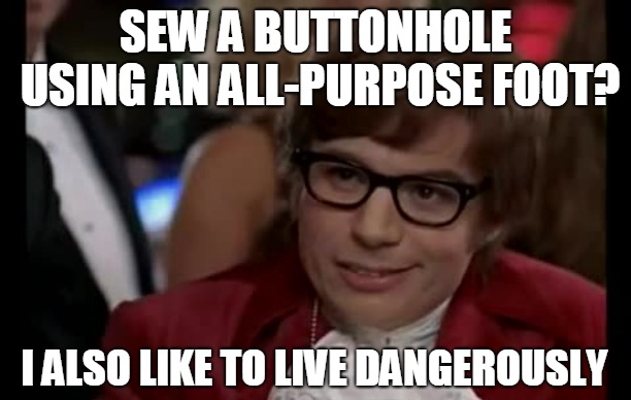
Serge the lower edge of the pant legs, then press the hem allowance upward and hem them by hand.
Hand-sew six buttons to the waistband facings for the suspenders/braces.

